This is South Korea’s largest island. Jeju has a little bit of everything: relaxing beaches, thrilling hiking trails, thematic parks, dense forests, volcanic cones covered in lush plants, UNESCO cultural heritage sites and obviously excellent and fresh seafood.
Day 1
We usually start the day with a very long sightseeing itinerary, which is gradually, but surely distorted once we find a perfect spot. Our first day in Jeju started from our hotel in Seogwipo and we moved towards the east coast for a day filled with nature trails, cultural shows and some beach relaxation. The roads in Jeju are well maintained and signalised, there’s little traffic in most parts, but the speed limit is around 60kph in most areas. So even though Jeju is a rather small island, traveling from one place to another takes quite some time.
Our first stop was the Seongeup Folk Village which features some traditional Jeju houses made of lava stones and mud with thatched roofs. There’s quite a few houses here, along with a peddler’s inn and a former guesthouse for those in higher social rankings. Eric enjoyed a little run and hide and seek around the small houses. The entrance is free. There are restrooms in several places and some simple non-assuming cafes outside. People barely know an English word so it’s a little difficult to interact. There are quite a few villages of this kind on the island and it is a fun an interesting way of showing the little ones how people used to live a while ago.
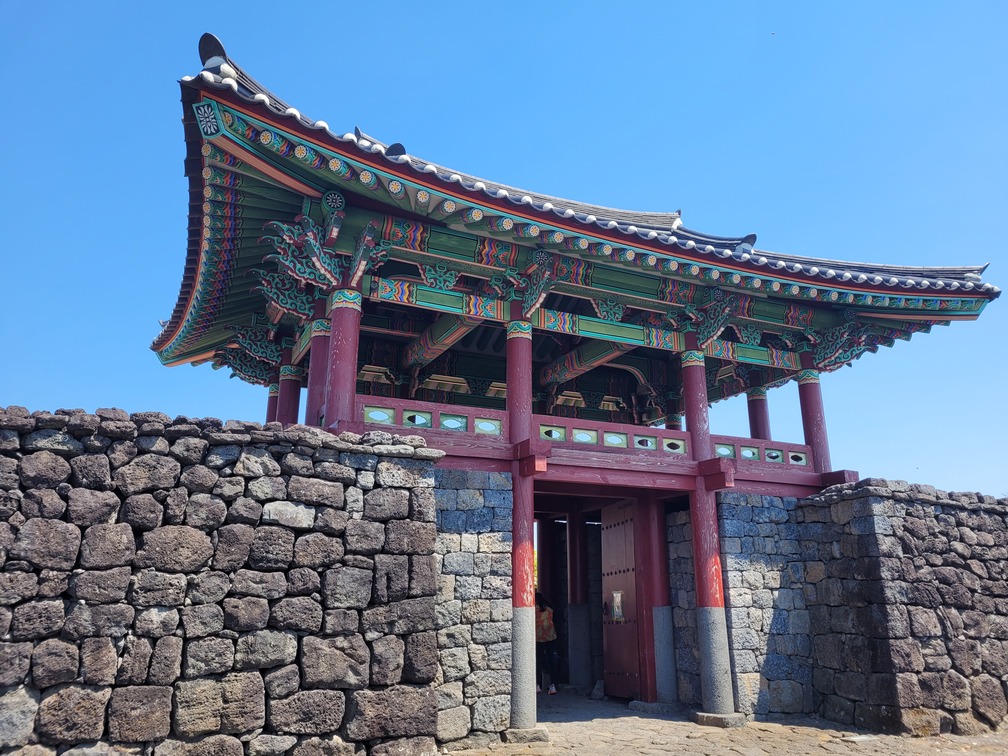
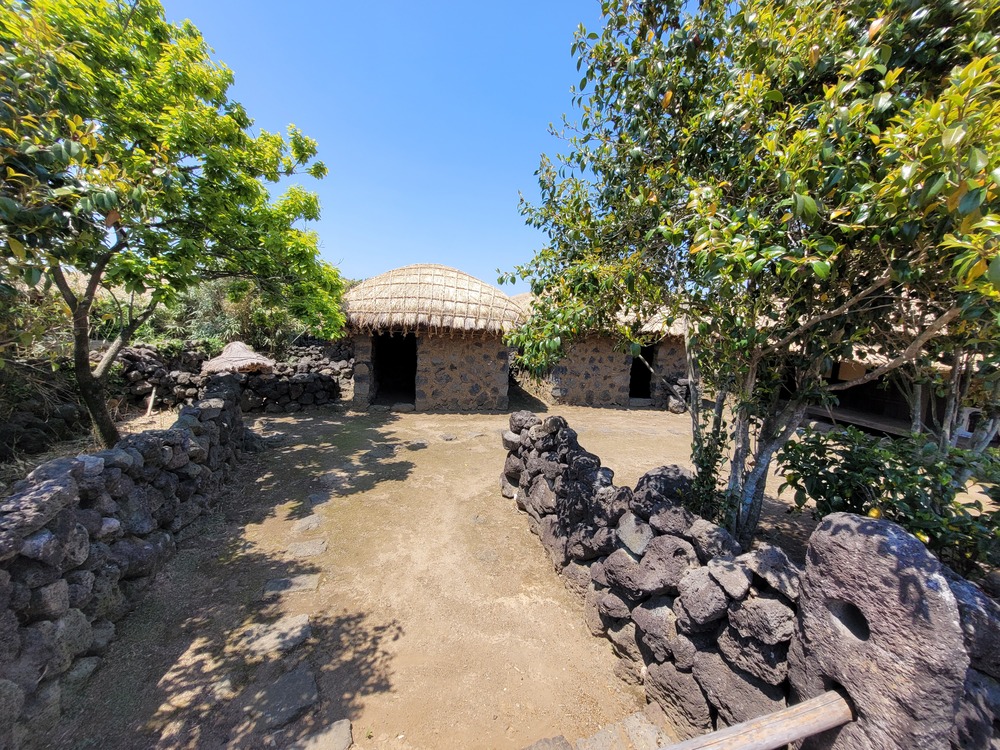
Our main stop for the day was the Seongsan Ilchubong (Sunrise Peak). There are signs directing the visitor to the main entrance which boasts a huge parking lot (free, address here: 137-1 Seongsan-ri, Seongsan-eup, Seogwipo-si, Jeju-do). There are quite a few (modern looking) cafes around the parking lot. The hike to the top of the volcanic crater takes about 30 minutes and it is quite demanding for the less experienced hiker. Eric basically ran the stairs up and was feeling fresh when we arrived at the top. The normal trail has an access fee (5000 krw for adults, 2500 krw for teens/children). There is a free trail which is rather flat and goes up to the Hanyeo women diver show and the observatory point. We opted for the hike up and it was totally worth it. The views along the way are breathtaking.
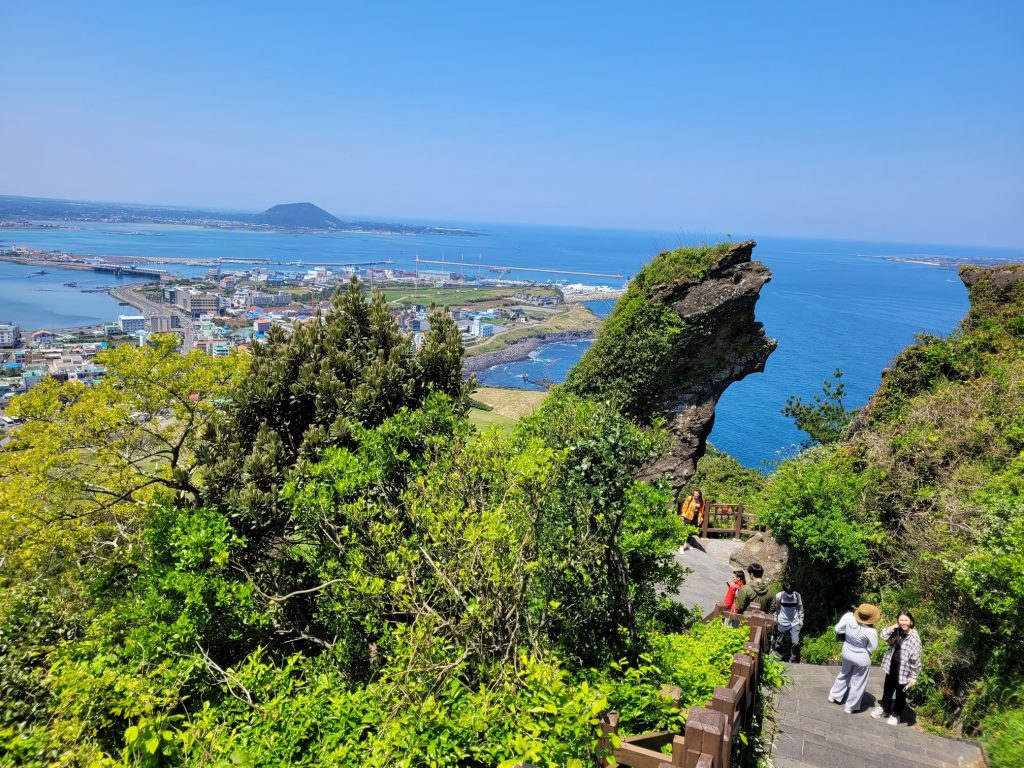
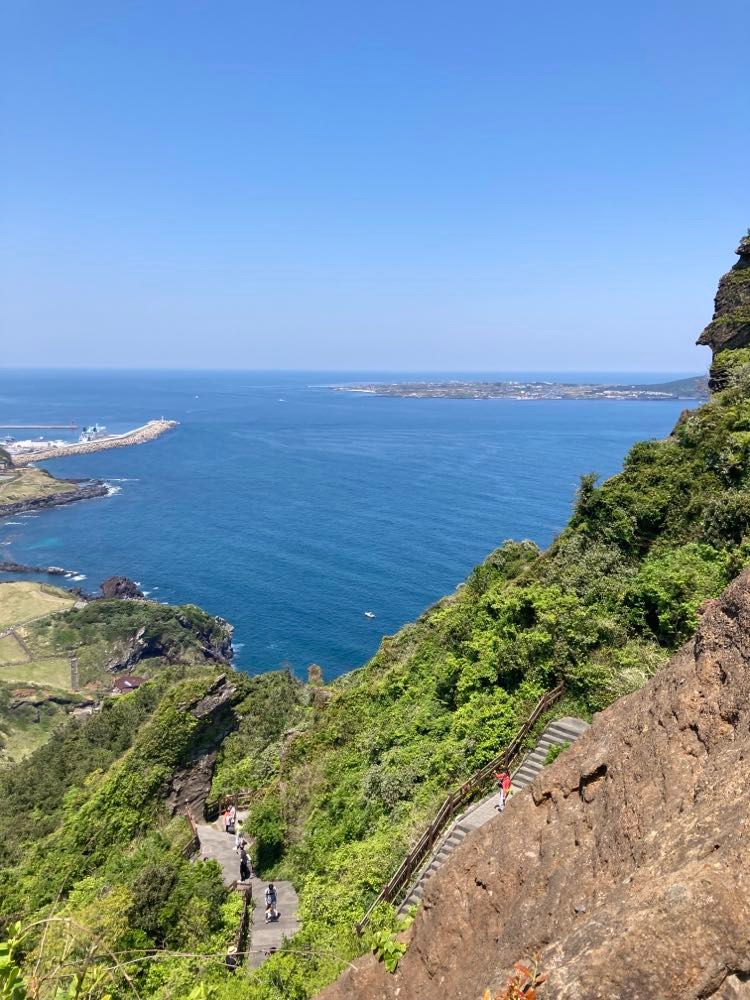
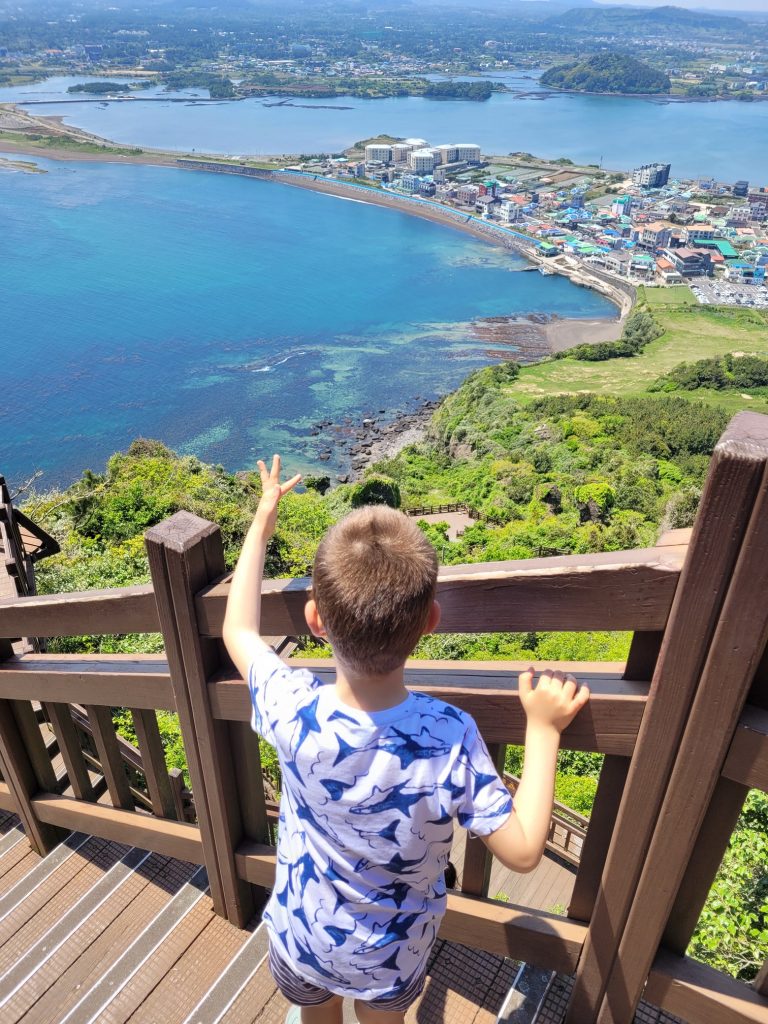
But the highlight of the short and intense hike reveals itself just as you climb the last flight of stairs: an amazingly green crater silently awaits. As we went up, we stopped along the way once, near the “Lamp”. This is basically a vertical thin rock that has a story to tell. As Eric is a fan of stories, I did not miss the chance to tell him that Jeju was gradually built by a goddess that used to carry in her dress mud and rocks all day. As the night fell, she would light up a lamp and sew back her dress near the vertical thin rock so that the next day she would be able to carry in her lap rocks and sand to continue building the island. As Eric was eager to hear more, I told him about the way the Sunrise Peak was formed. It was a good opportunity for us to recall our underwater volcanic experiment that we did back home.
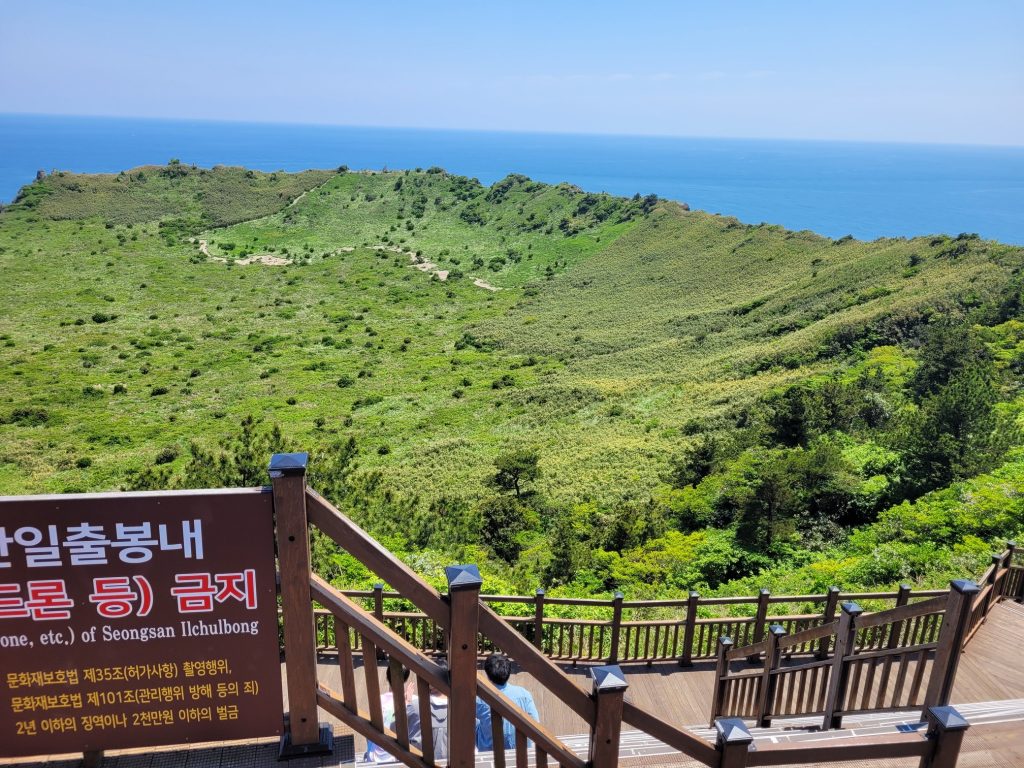

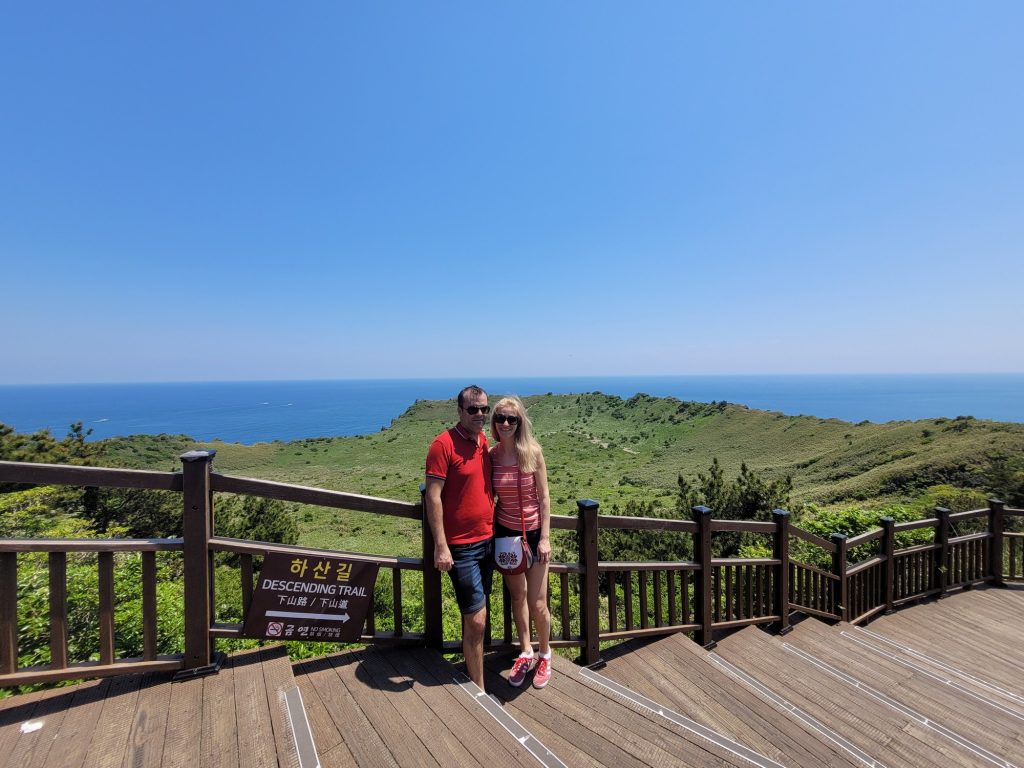
The descent from the top is light and offers some unique photo moments. We hurried a little as the Hanyeo show was scheduled at 13:30PM. (There’s a second show at 15:00). Unfortunately, the show was cancelled on that day, so we did not see the actual diving performance. The show takes place at the bottom of the Sunrise peak and getting there is easy. It is accessible from both the free and the payable trail and there are signs that show you the direction. We finally decided to decent to the small bay at the Hanyeo restaurant to check out the black sand beach. This only added to Eric’s excitement as the water is shallow and rocky with plenty of seashells of various types and colors. We collected quite a lot of those, especially the abalone ones, which are famous in Jeju. In many ares, divers are no longer allowed to catch these shellfish as much as they used to. This is why abalones are quite expensive. The Hanyeo restaurant sells fresh shellfish and sea cucumber to be eaten raw on the spot. It has a small terrace where guests can enjoy their meals. There are also small boats that offer a ride around the peak. The price was 10000krw for a ride.
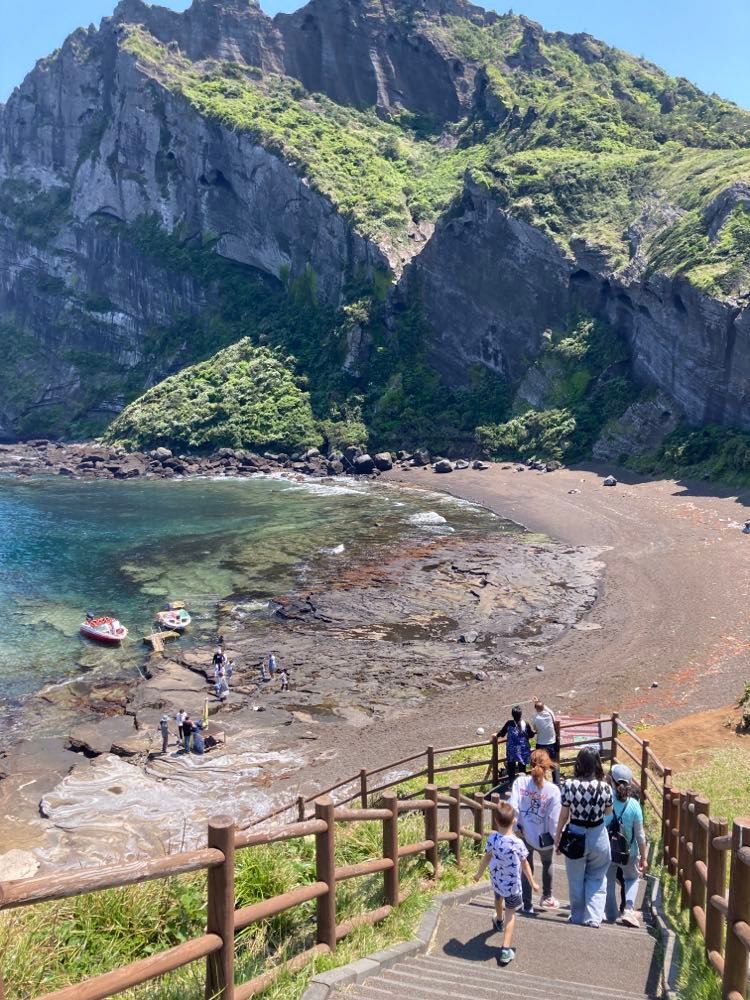
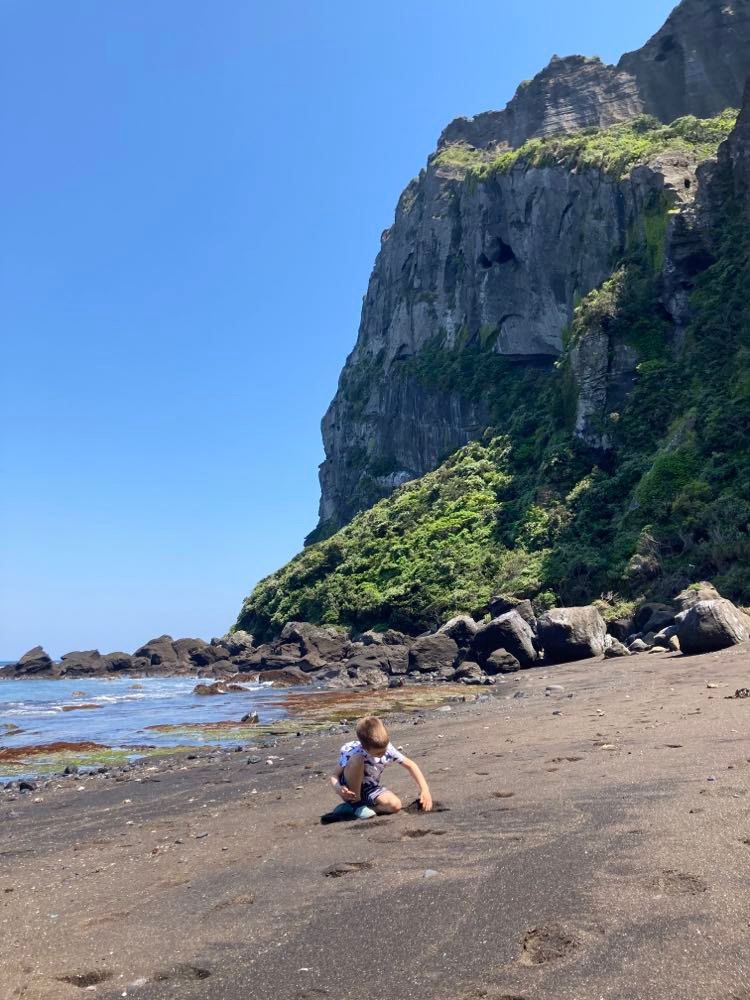
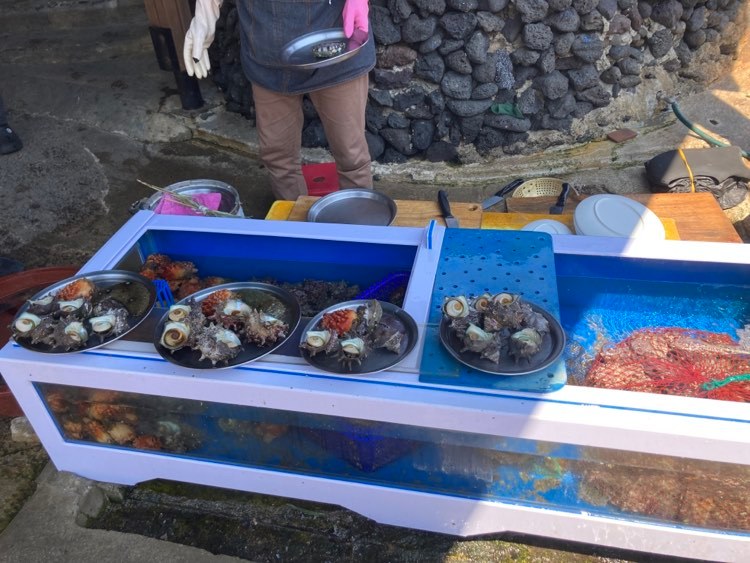
It was already lunch time so we took Ilchul-ro road down to town. Along the road there are souvenir shops and tangerine/citrus selling shops. Tangerine is primarily cultivated here for South Korea. We payed 5000 krw for a basket full of kumquats and 3000 krw for a small bottle of juice. Eric doesn’t like kumquats…or better, he didn’t like kumquats. In Jeju he practically devoured kumquat after kumquat. They were indeed delicious. We stopped at a Korean restaurant just down Ilchul-ro (281 Ilchul-ro, Seongsan-eup) that had no English menu and no English speaking waiter, but in the end ended up with a nice jorim fish and a mackerel stew. The entire meal, with several side dishes, seaweed soup and rice for 6 people, along with water, beer and cola was roughly 137000 krw. You should try some ice cream while on the island, the Hallabong kind (sort of like mandarin), which is the popular flavour in Jeju. Most ice cream shops sell also peanut flavoured ice cream. We tried both. Peanut was better for our taste.
The evening found us strolling along the very scenic coastline of Seopjikoji. The area is very well organised, free parking available right at the entrance. There’s a beautiful restaurant offering an amazing view towards the stunning sea, the cliffs and the mesmerising light house. Right next to the restaurant there’s a giant swing, which looks very instagramable and a heart shaped sculpture that’s very photo worthy. Sunset in this area only added to the magic of nature around us.
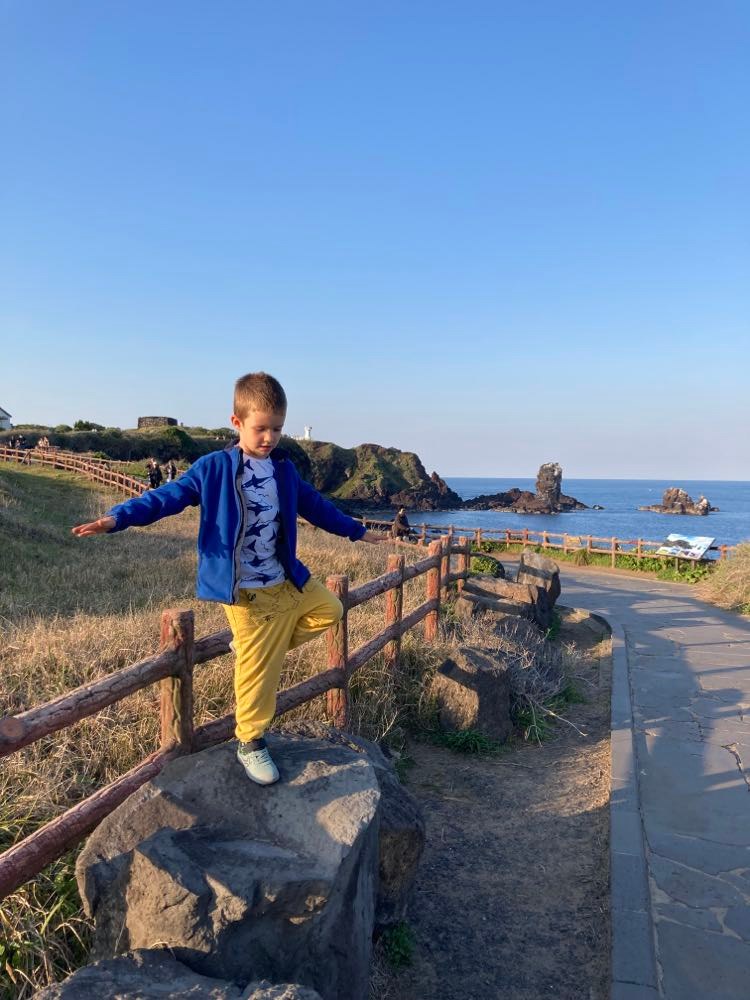
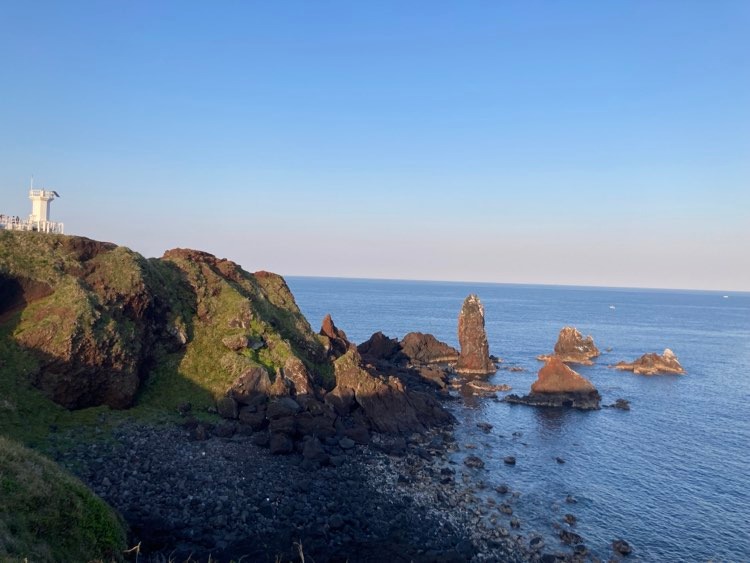
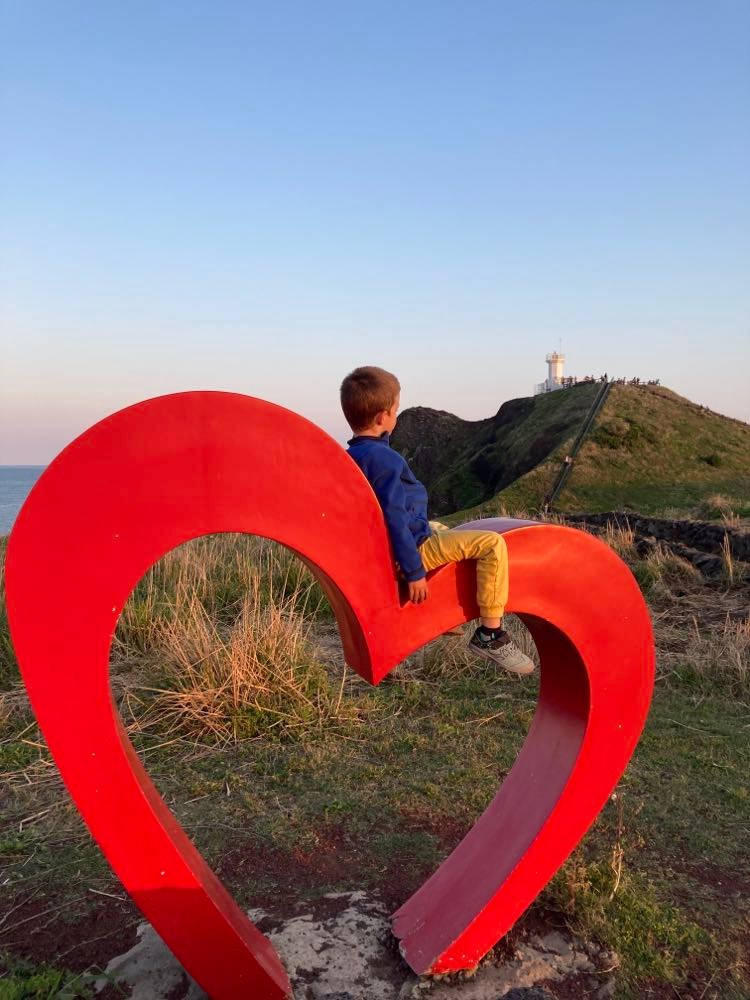
Day 2.
The second day, we went for the north-east side of the island with a very specific target on my mind: the Manjanggul Cave, one of the largest lava tube caves in the world and obviously part of the largest system of lava tube caves in the world. Unfortunately, we did not check operating hours and the cave was closed for monthly maintenance. So then, we just moved on to the next stop, which is very near, the Gimmyyeong Maze Park. Initially considered as a stop for Eric to play around, me and one of my friends found it rather interesting to solve. Make sure you take a leaflet from the ticket booth. There are 7 stamping stations along the maze where you can get that leaflet stamped. The maze has an interesting symbolism as it represents the five periods of Jeju’s history and the cultural beliefs (pony head -arrival of the Mongols, snake – rituals and beliefs of the islanders, dolmen – turning of the hunting island society into an agricultural one, ship – the first western ship arrival in Jeju, yin yang – philosophy of East Asia) and two symbolic geographical statements ( the coastline, the east/west declination of Jeju’s location). The Park has numerous cats just wandering around, it has picnic spots, playground areas, billiards tables, air hokey. Make sure you time yourself while finding the exits to see how well you did (statistics says that 5% find the exit in less than 5 minutes). There’s a bell at the end of the maze. Ring it to state your success. Also, taking a photo while doing that will costs you some seconds…


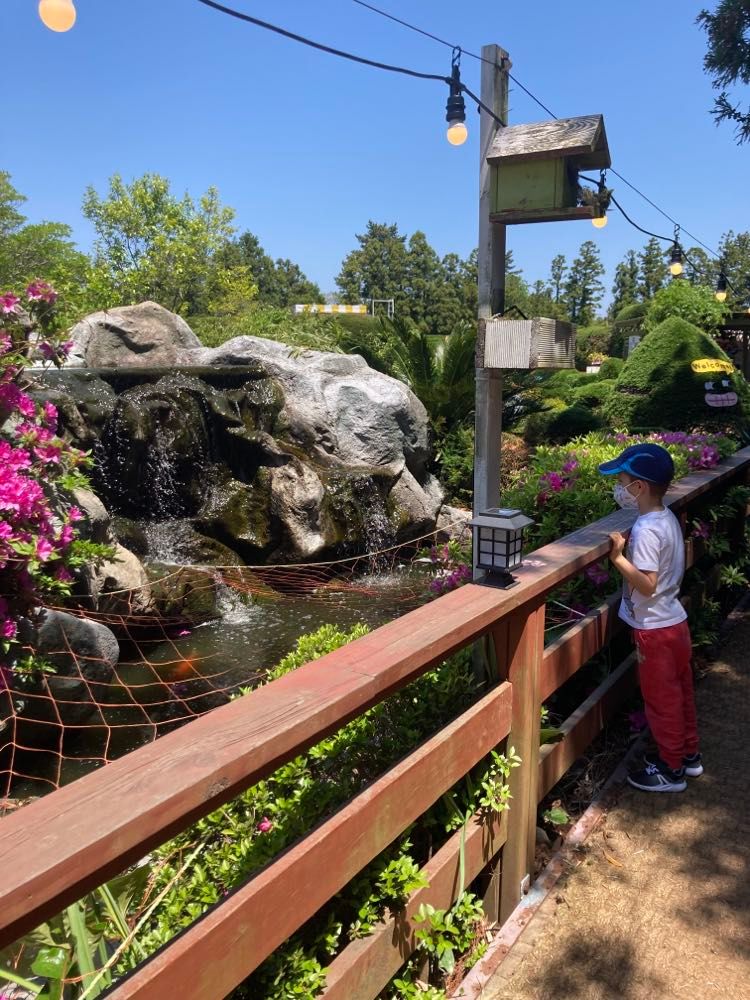
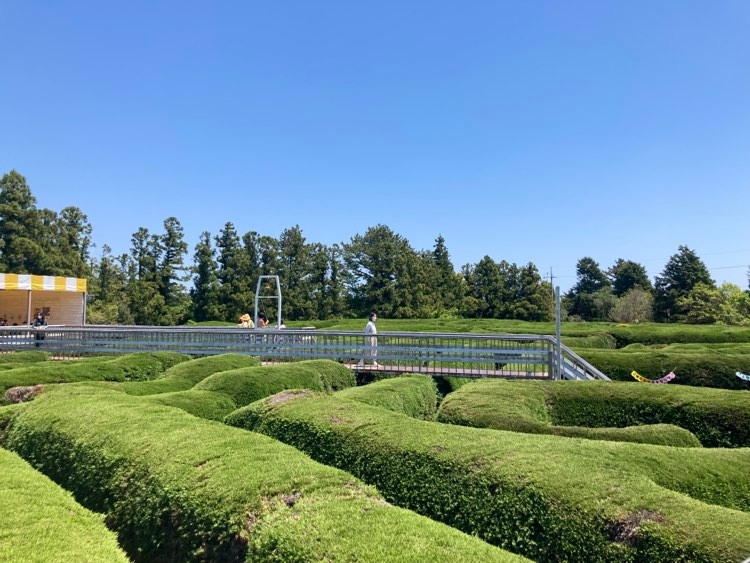
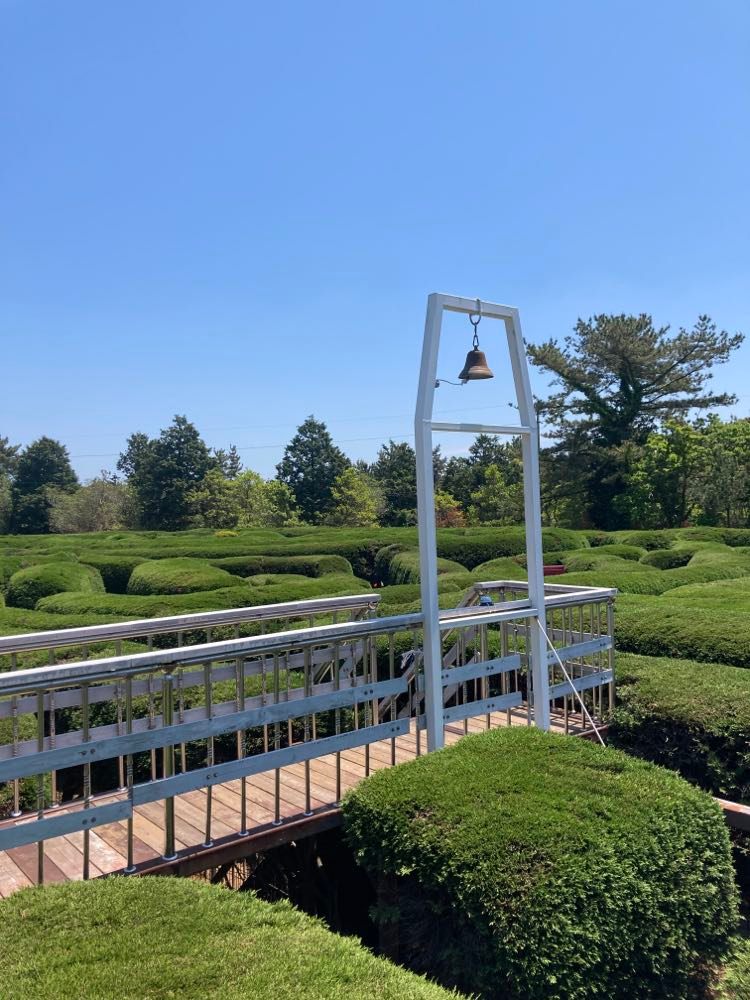

We spent the rest of the afternoon in Hamdeok Beach. This a sandy beach, with shallow waters. A perfect spot for families. There’s free parking lot nearby. There are shower and toilet facilities here, but there were no sun beds nor umbrellas to rent. We were in Jeju at the beginning of May so not sure if this is true over the summer, as well. There’s a beautiful cafe (cafe del Mundo) just to the left of the beach. Numerous convenience stores nearby, if you want cold drinks, fruits, snacks. GS25 was the one we came across on almost every corner in Jeju, with good range of products and decent prices. There are also a lot of cafes and restaurants on the main road, Johamhaean-ro. We opted for an Italian restaurant, as Eric was craving pasta. The restaurant overlooks the beach, the food is really good and very affordable.
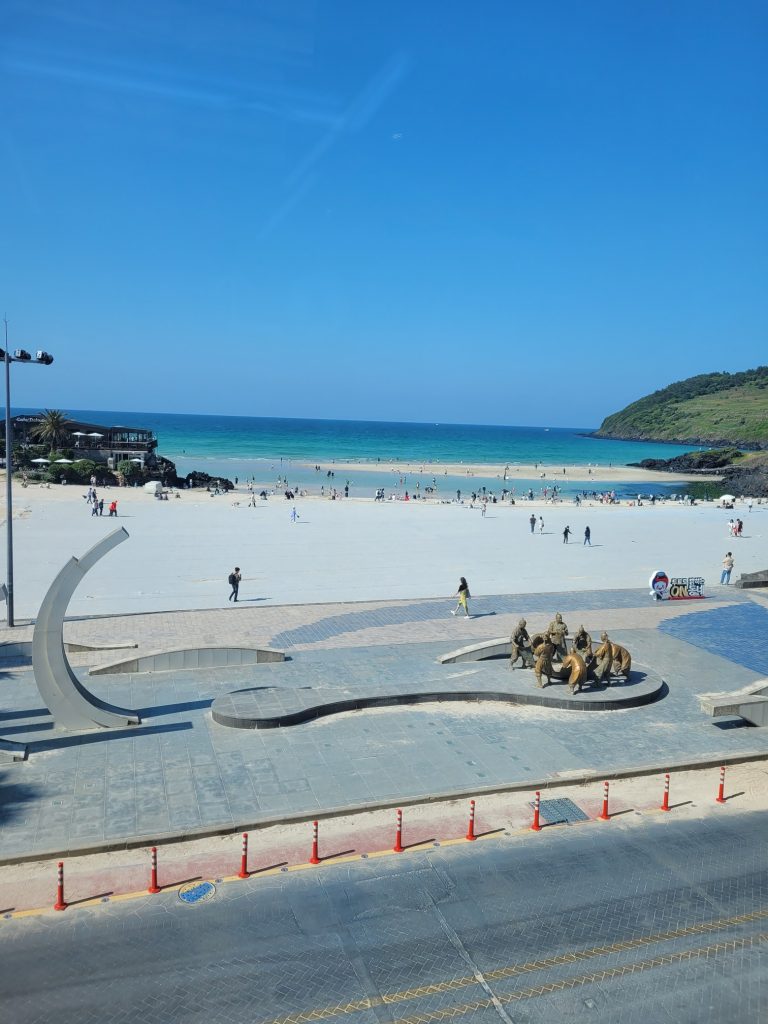
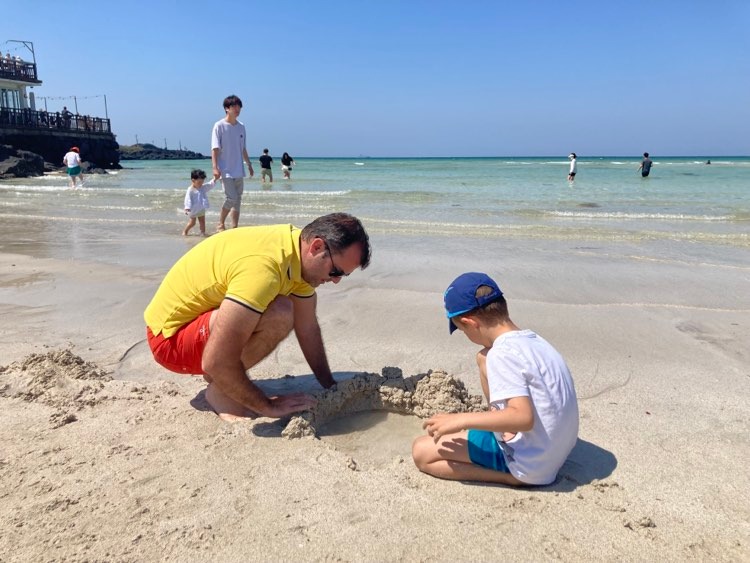
In late afternoon we returned in the south of the island, to visit Jeju’s sole waterfall directly cascading into the sea, the Jeongbang Waterfall. Free parking available here, as well. And once again, the island is very well organised for tourists. There’s a small entrance fee (this applies to literally any sightseeing spot on the island), but there’s a well maintained wooden staircase and pathway that takes you very close to the falls. Make sure you stay on the pathway and keep an eye for the snakes (it is afterall one of Jeju’s symbols).
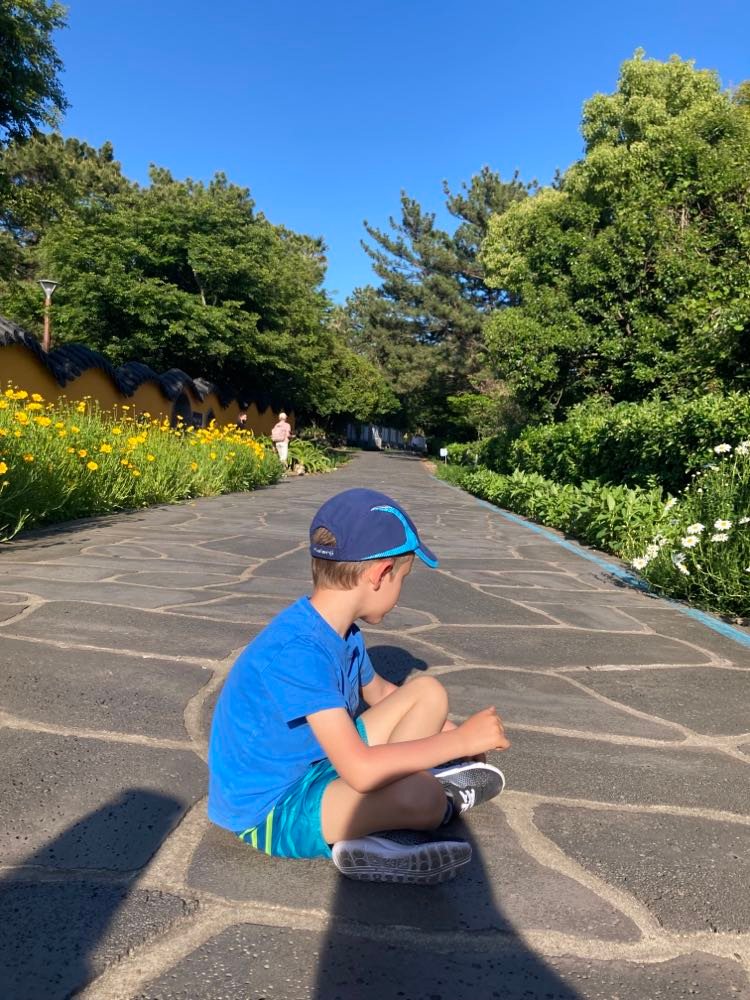
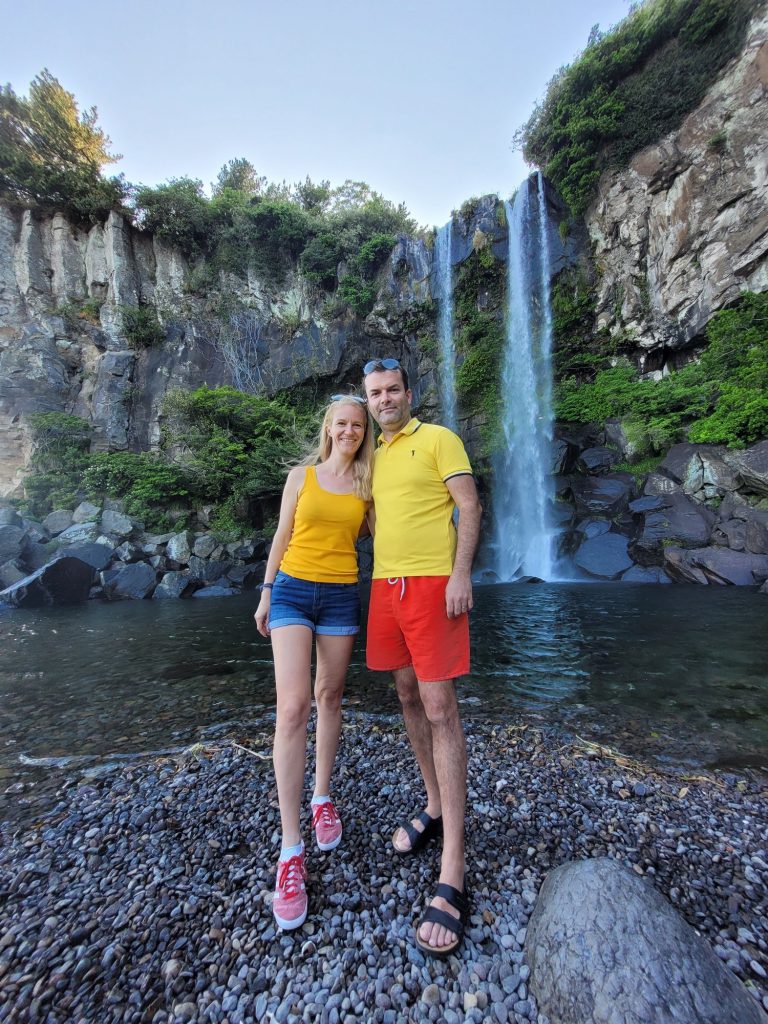
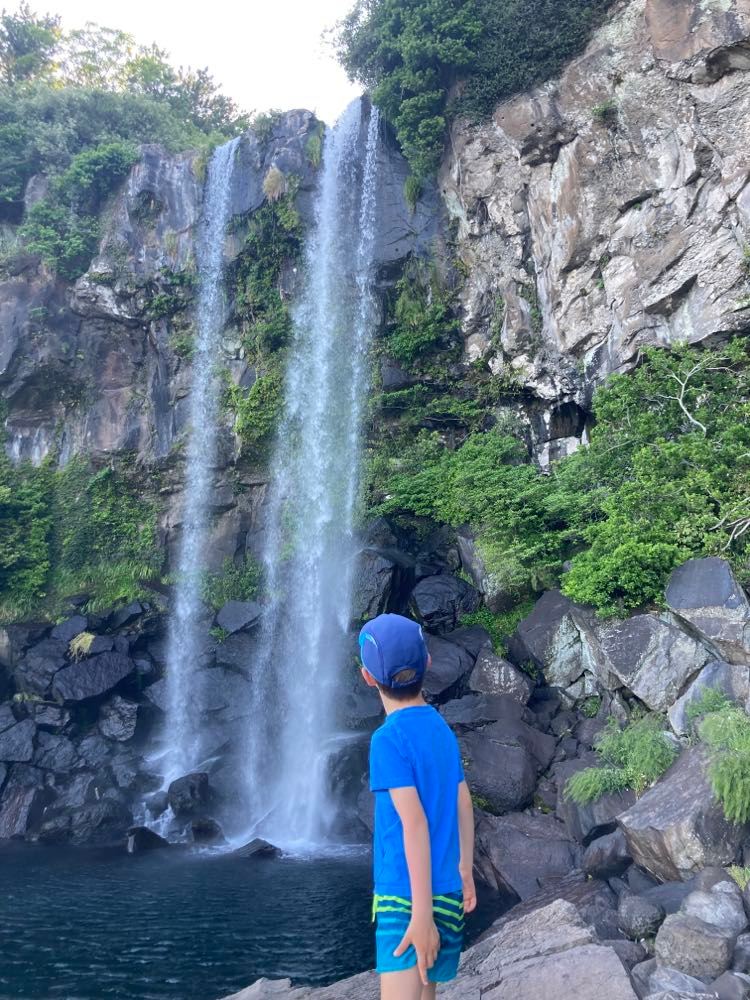
Our next stop was the Yongmeori Coastline. The whole area is gorgeous and it is part of the Jeju Olle Trails. The Sanbang mountain rests quiet nearby housing a budhist temple, the Sanbanggulsa. The are is filled with history. The trail is dotted with signs that explain how the area was formed. Myths and stories are told to entertain the young. In fact, the name of the coast in itself has a story as “yong” means dragon and “meori” means head in Korean. If you park here and follow the path to the Hamel Ship Museum, there are numerous food and drinks vendors along the way. Also, you come across a couple of “photo locations”, which are pretty common in Jeju. For a small fee, you can take your photo in a field of flowers or next to a horse. You can also ride a horse if you’d like that. This is available here. Apparently this is also a good spot if you want to have a photo on a horse with the Sangbang mountain in the background. During our stay in Jeju, we came to realise that this photo spots were created basically everywhere for tourists and locals, alike. There’s a little adventure park here as well, called the Sangbangsan Land, with some unassuming rides. But the true beauty of this spot is the coastline. This is a layered coastline as resulting from volcanic activity followed by water and wind erosion. The area is breathtaking and unique. And yes, it looks like a dragon’s head. The entrance to see the dramatic cliffs is right next to the Hamel Ship Museum and takes you along the entire coastline up to where it intersects with the Jeju Olle trail. Unfortunately, we arrived there after 6pm and then realised that most sights in Jeju close about this time. Make sure you also check the tides, as the coastline is only open during low tide. There are no safety fences so kids should be very closely monitored. Obviously, the walkway can be slippery. There are also hanyeo women that dive and offer fresh sea food on the spot.
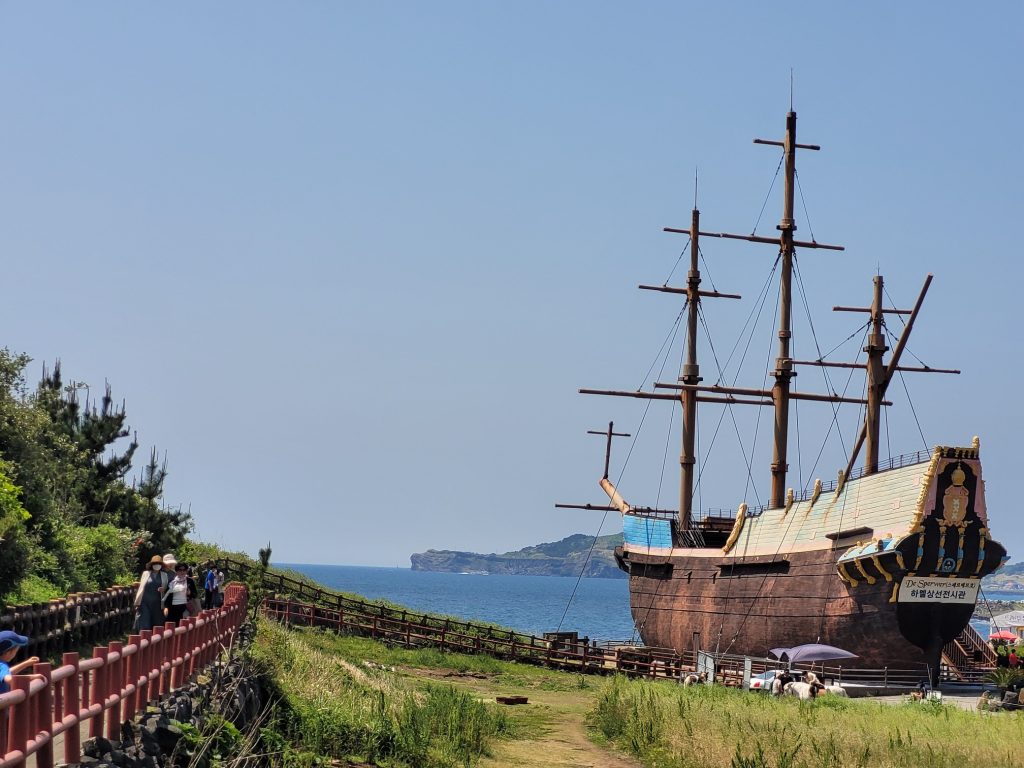
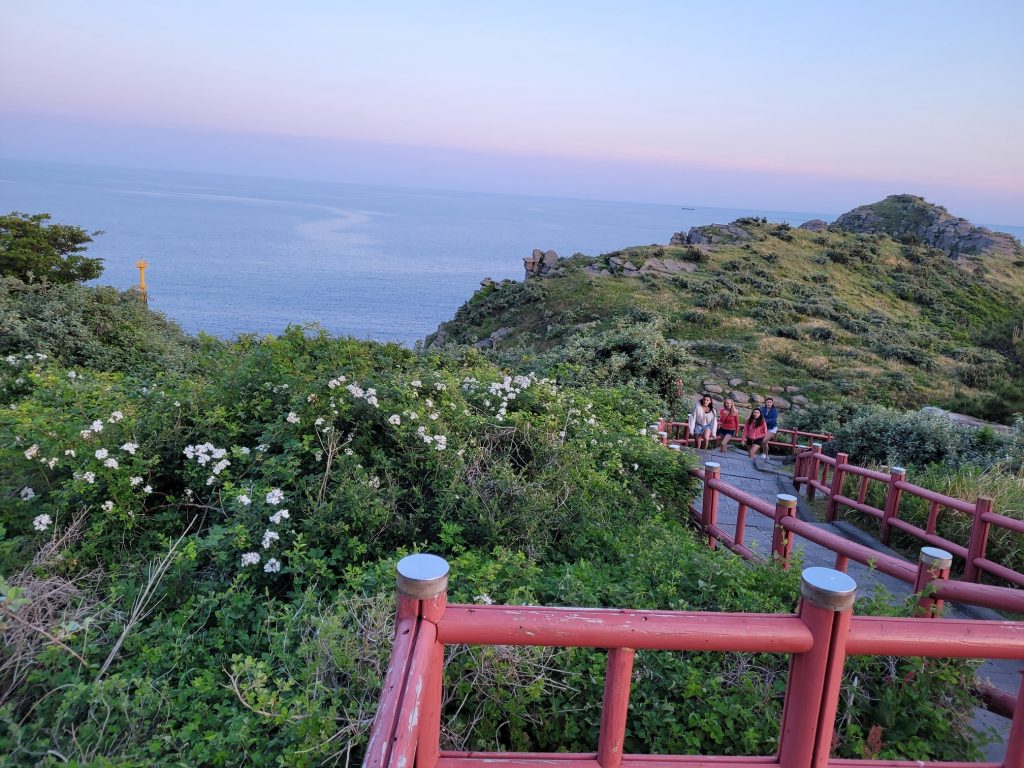
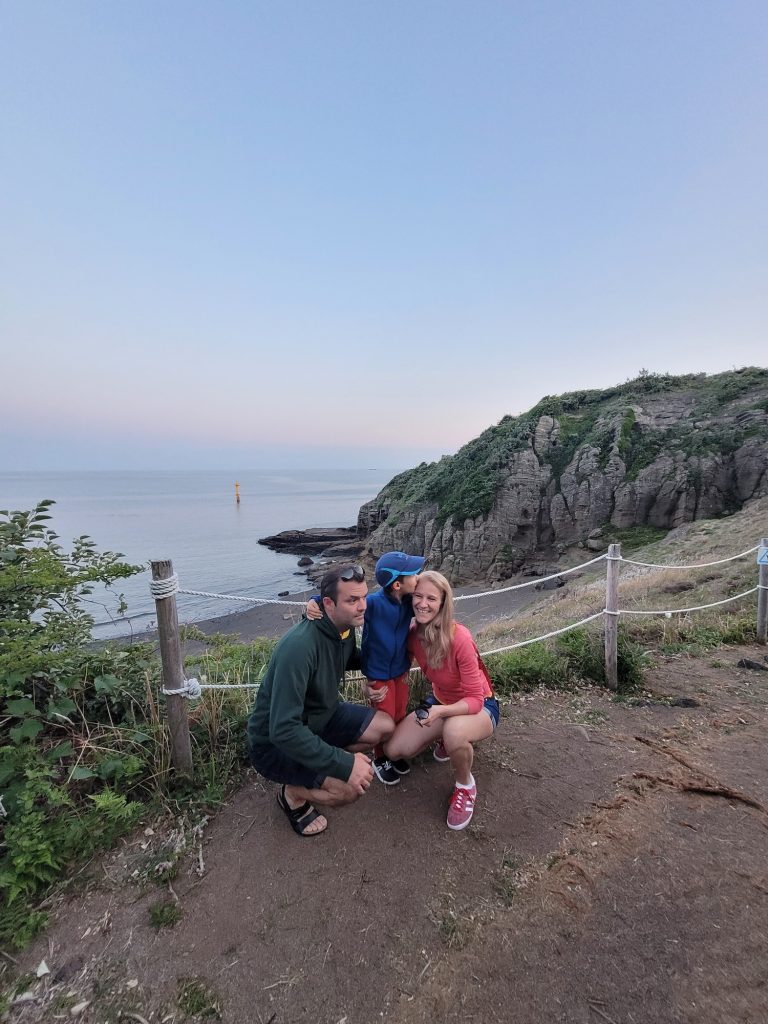
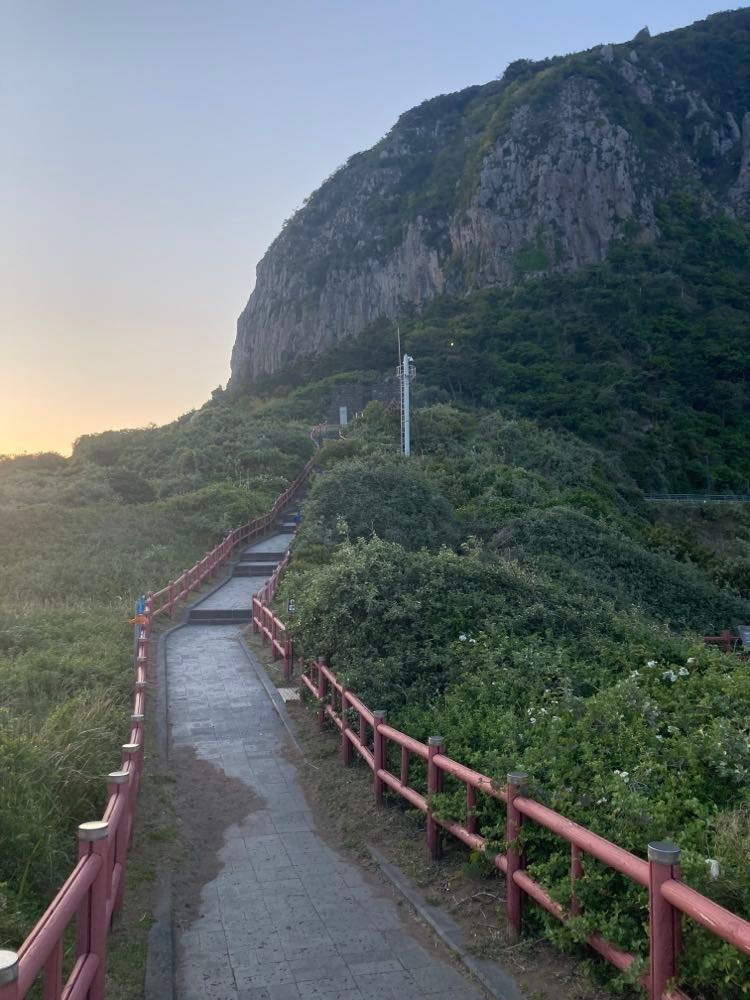
Since we were unsuccessful in our attempt to see this amazing rock formations, we took the Olle Trail up to the nearby One and Only Cafe. The view is great, but you do not really get to see the Yongmeori Coastline. Another thing we realised that evening: restaurants in Jeju close rather soon. And it was quite the struggle to find a restaurant that served dinner after 9pm. We did find one and the black pork barbecue was delicious (we were also starving, the menu and the staff did not speak English, so I am kinda hoping it was black pork – Jeju is famous for black pork).
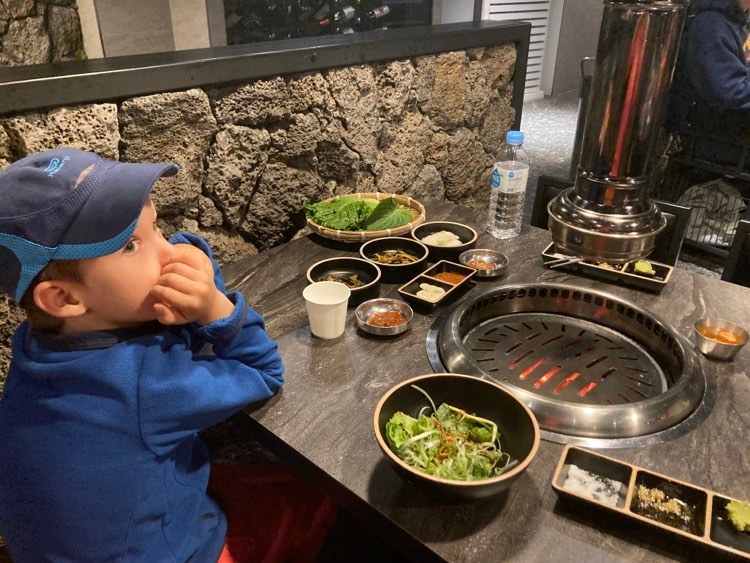
Day 3.
As we sort of checked the major sightseeing spots in the eastern part of the island, we focused on its western part during our third day. Our first stop was the Osulloc Tea plantation and museum. We arrived there around 11 am and the tea plantation was nearly empty. One hour later it was packed with people aiming for the best photo. I would recommend getting there even sooner than we did. The Osulloc Tea Museum is on one side of the road, while the large tea plantations are on the other side. We parked next to the tea plantations, over here, took our photos and then crossed the road to the museum. The museum houses a coffee shop with some exquisite cakes, shakes and ice creams. All having some sort of a tea flavoured component. I loved the Halla Mountain Green Tea cake (7000 krw/piece) and Bogdan ate a smooth tea cheesecake. We added some tea and Hallabong milk shakes to it and two cups of ice creams (5000 krw/each). There is a lovely inside sitting area but the terrace in the manicured garden is the place to relax and enjoy. Innisfree Jeju House is literally 2 minutes away and features a cafe and a cosmetic store where you can easily spent hundreds of dollars in a minute. There is a wide range of products based on (surprisingly) tea, volcanic stuff, jeju bija seeds, etc. Inside there is a stamping station that Eric absolutely loved. There are blank postcards available and various stamps with some of the characteristic features of Jeju: a volcano, a horse, tea flowers, mandarins, Jeju island, an airplane, the famous “stone grandfather”etc. Eric spent some time stamping a loooot of postcards, while I filled my bag with looooots of skincare products. This is a must while in Korea. They are renowned world wide for their excellent skincare cosmetics. And obviously, both the Osulloc and the Innisfree cafes sell tea, which is not that cheap. Cosmetics were a bargain compared to the tea prices.
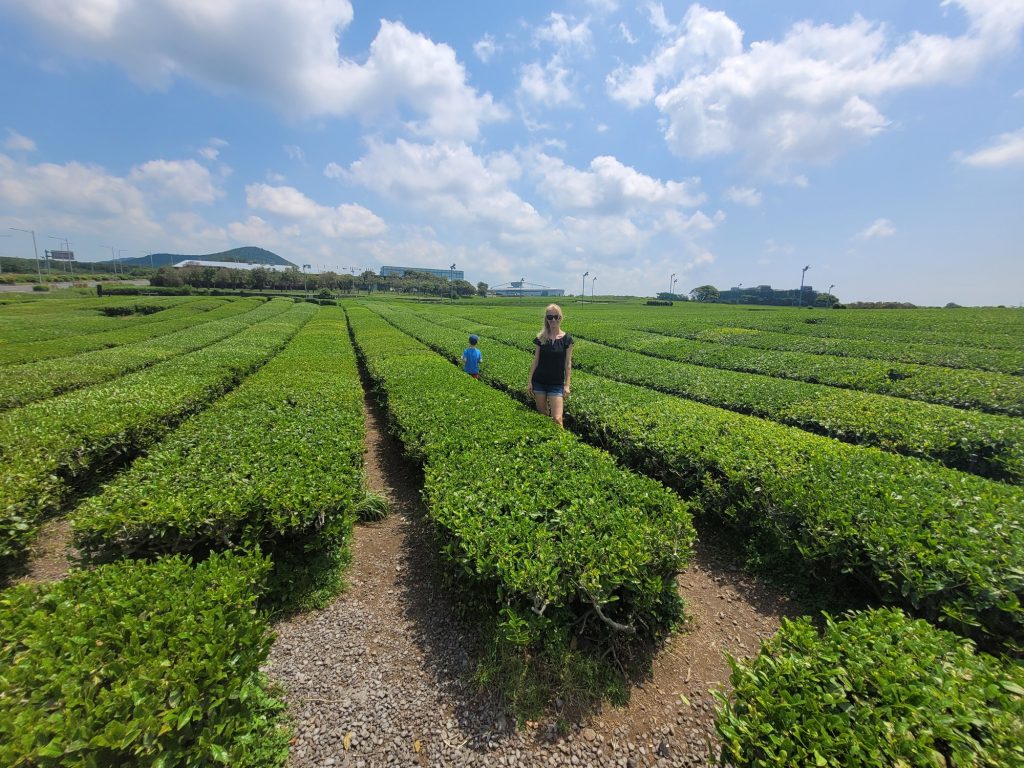
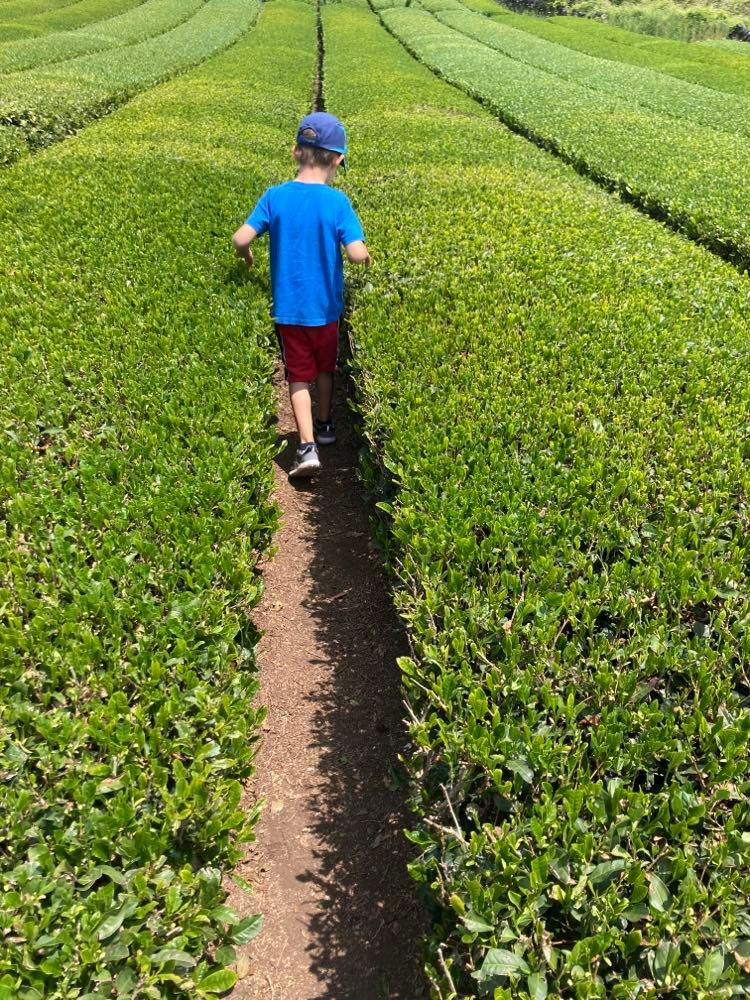
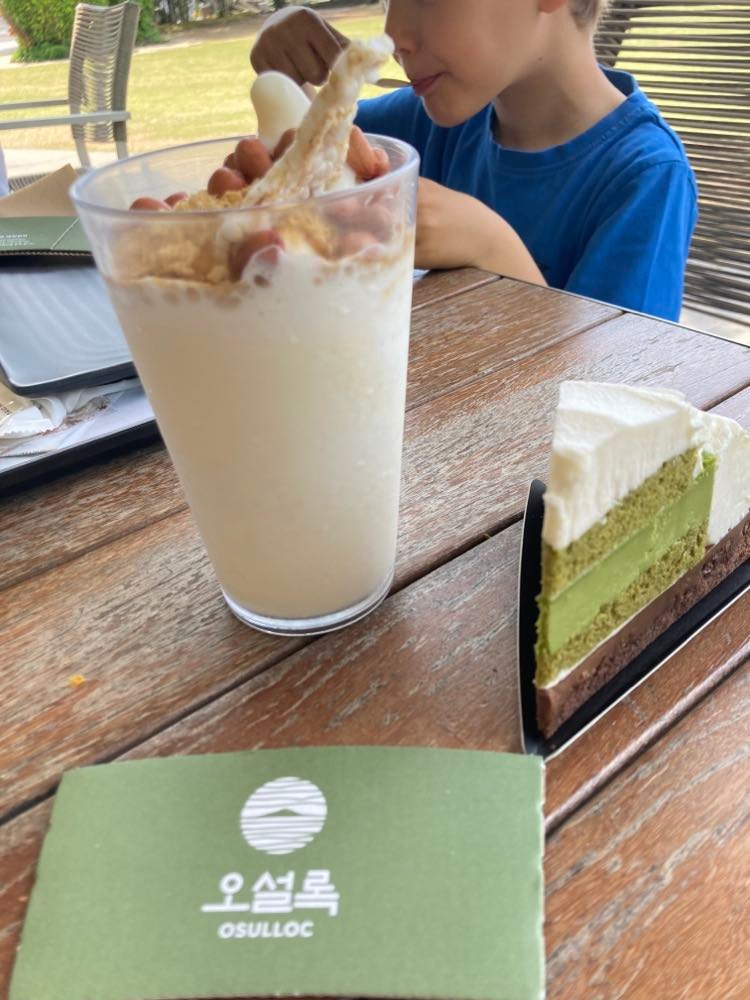
A short ride away is the Hallim park. Parking is available wight at the entrance. The garden is organised in numerous areas where specific plants are grown and features 9 thematic zones.The leaflet you get at the entrance indicates the month when each plant is in full blossom and where it is located. The thematic zones are also indicated on the map. Since we missed the famous Unesco listed Manjanggul cave, we were primarily interested in the Hyeopjae and Ssangyong Caves inside Hallim Park. From the ticket office, we first headed right to the water garden (one of the theme zones) boasting a really cool waterfall. To keep Eric entertained we initiated a nice little game. There are some nice sculptures of tortoises and frogs all around the waterfall and the lakes, so it was time for a little “find the frog” game. He was pretty much amused and willing to continue in our quest to find the caves.
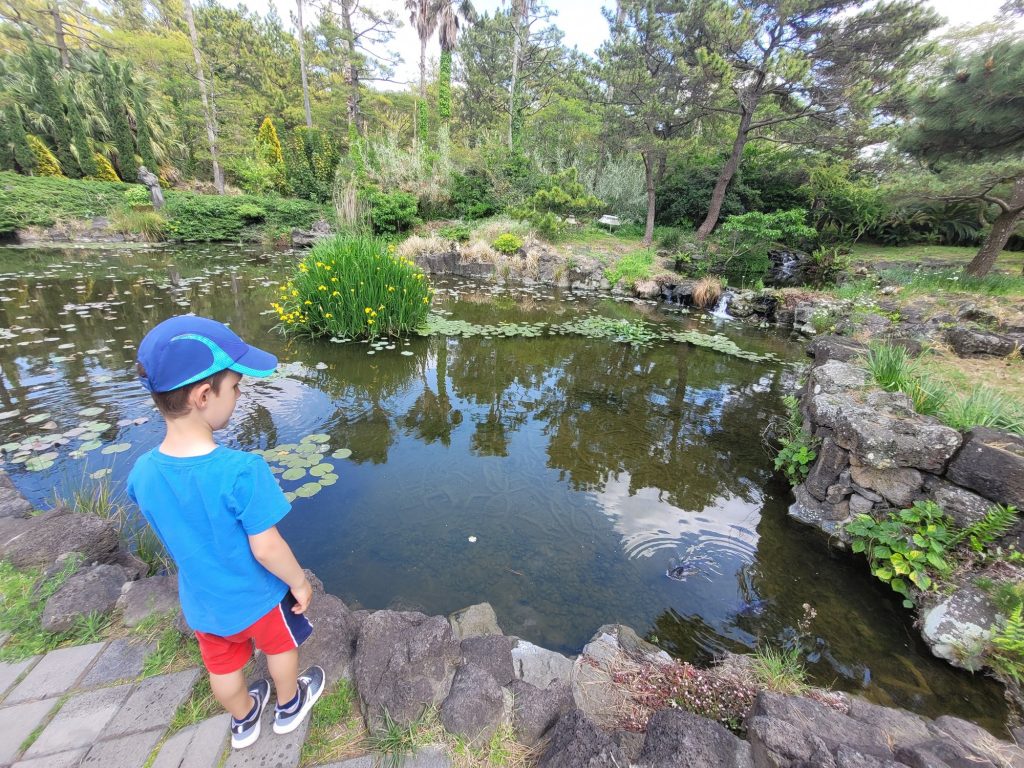
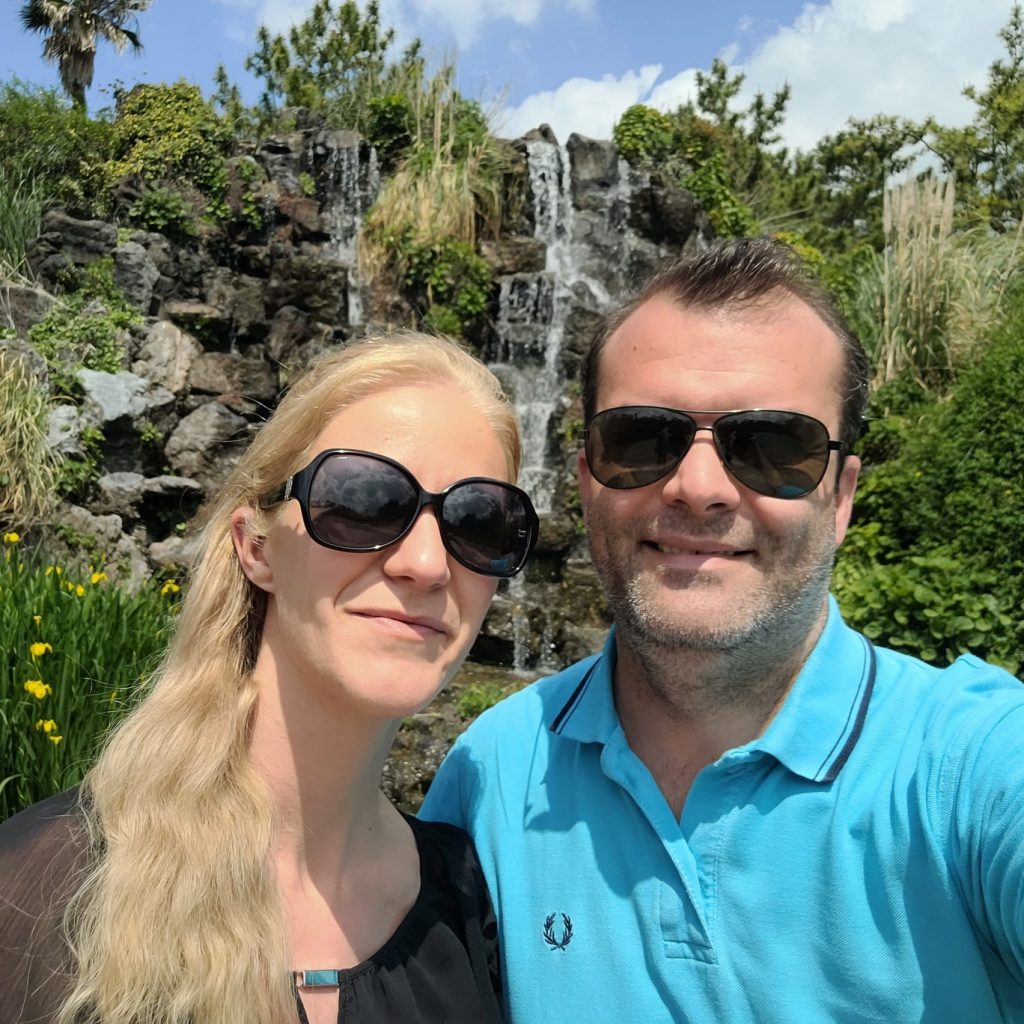
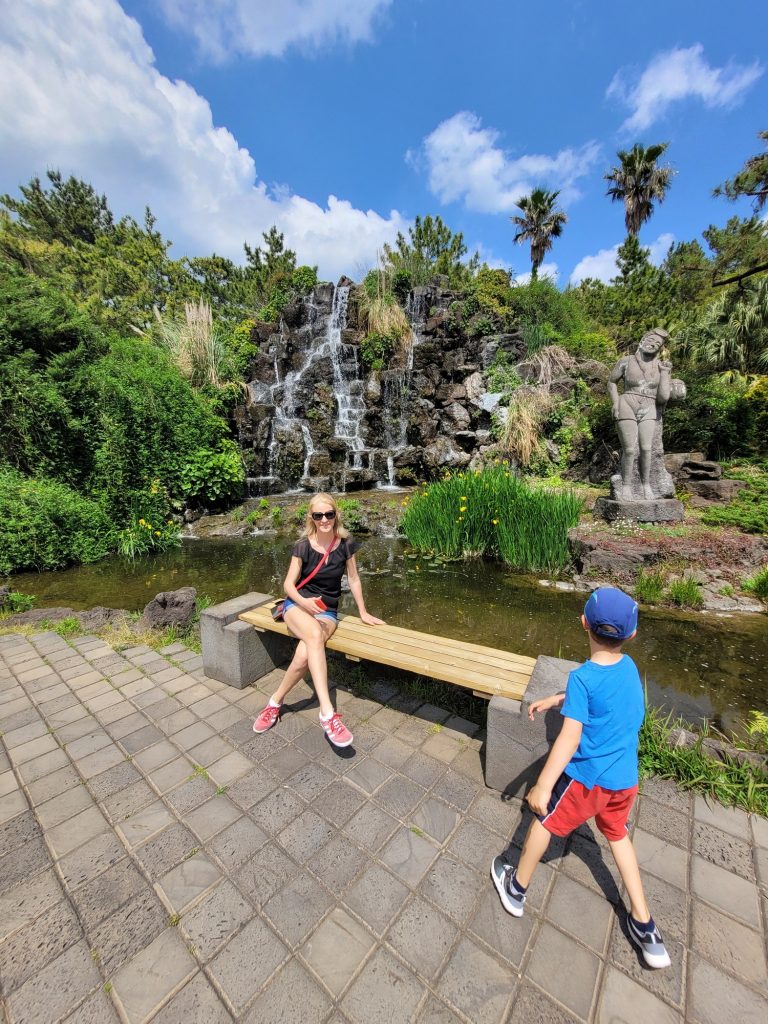
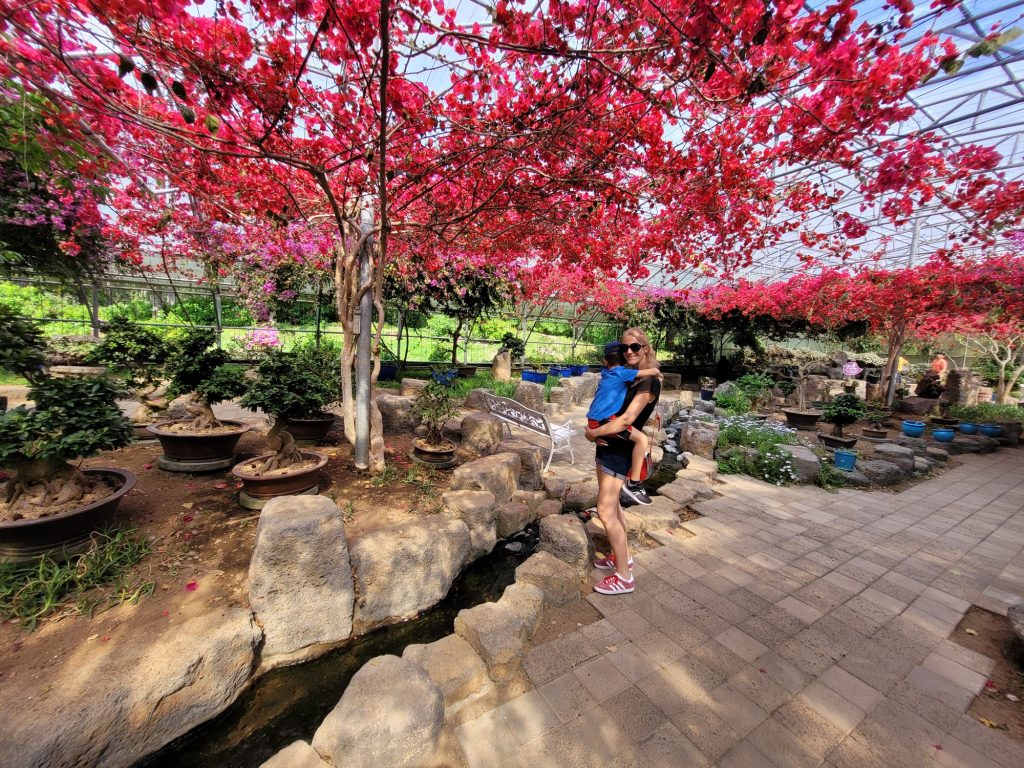
On our way to the caves, we passed along the bird garden and the Joe-Am Folk Village (also worthwhile in case you didn’t get to see the traditional Jeju houses yet). The bird garden is not very impressive, except for the male peacocks that seem to be trained to show off and pose for photos. Take a right after the folk village and you will find the entrance to the two caves. The first one is the Hyeopjae Cave, a tubular lava and limestone cave, where unique stalactites and stalagmites form. You can really see the way the lava flowed towards the second Ssangyonggul cave and how different layers dried out. Both caves were created by the eruption of the Hallasan Mountain 25 millions years ago. Before coming to Jeju, Eric and I did a little experiment with an underwater volcano, to show him how the island was created. We also followed with a terrestrial volcano and talked about the lava tube caves. Eric was amazed to see it with his own eyes. The Ssangyonggul and Hyeopjae Caves are believed to have been submersed in the sea, as seashells and abalones fossils were found in the walls of the caves. Jeju really offers an exciting way to teach the young ones about volcanic activity, about fossils and how they are preserved, about erosion and how paleontologists figure out the way the Earth was millions of years ago. We actually did a little project when we returned on paleontologists just for a better understanding of the topic. While walking through the two caves, I told Eric a nice little story about the Ssangyonggul one. There are two branches of this cave and the inside look as if a dragon has passed. Eric was able to see the tail and the body of the dragon, which we found amusing.
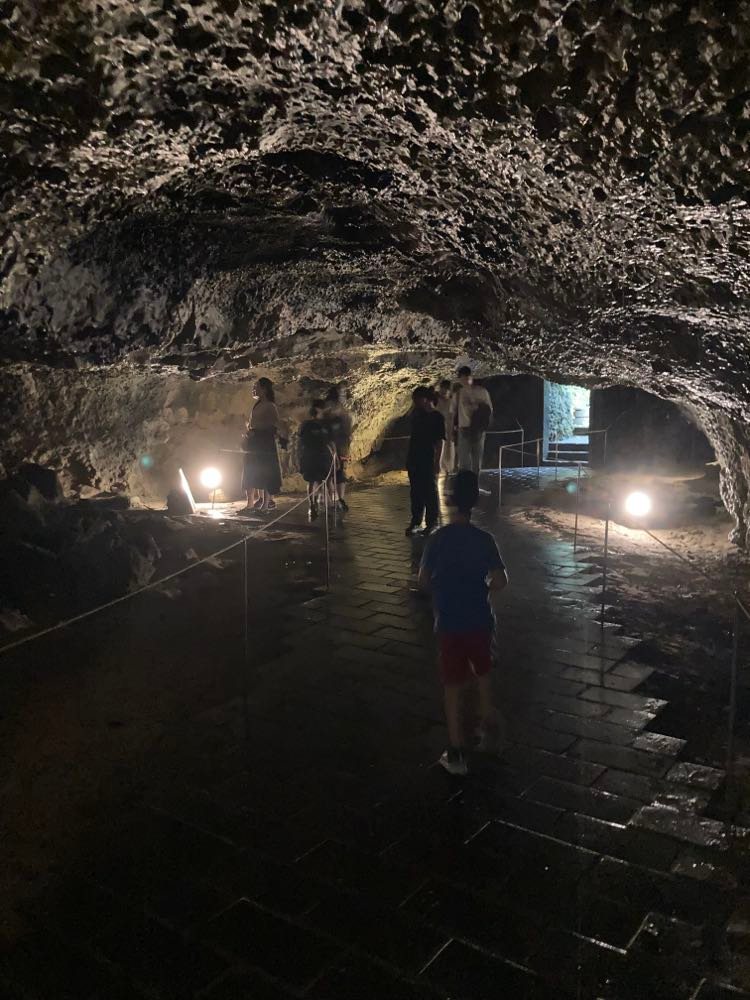
From the exit of the caves we went straight ahead to the Stone and Bonsai Garden, which was the last spot that we wanted to see in the Hallim park. The famous “stone grandfather” made of the porous volcanic rock is displayed here, as in all areas of Jeju (it’s one of the symbols of the island).
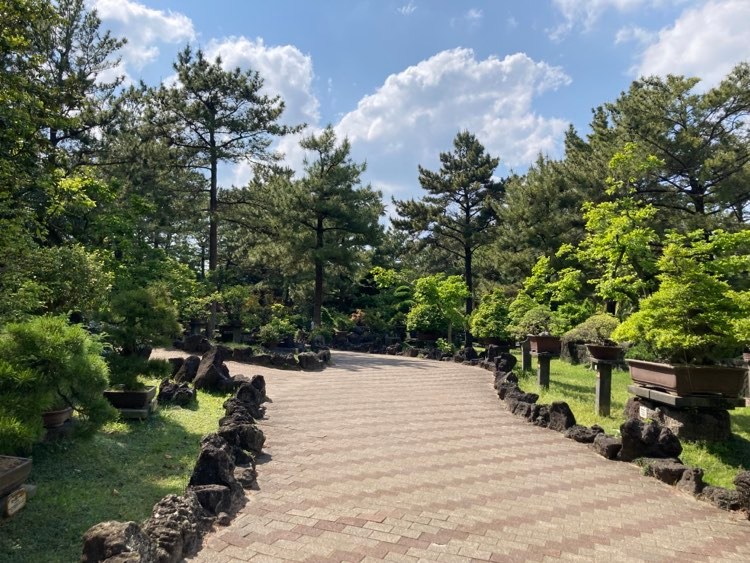
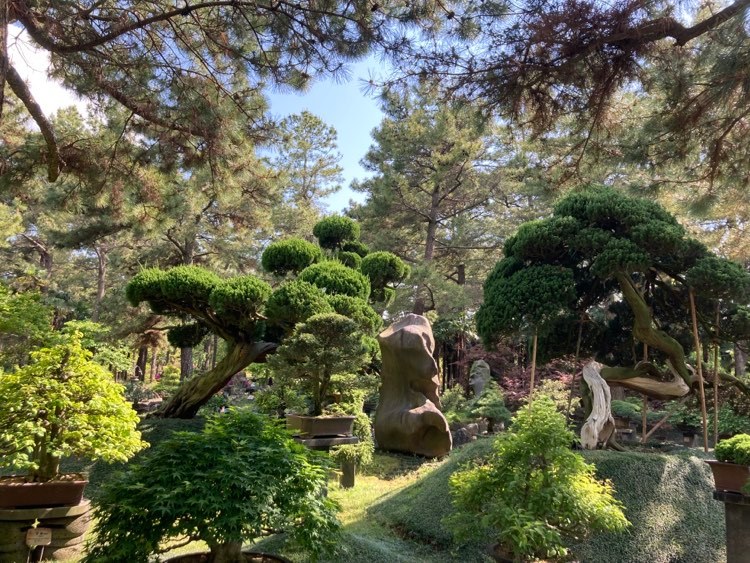
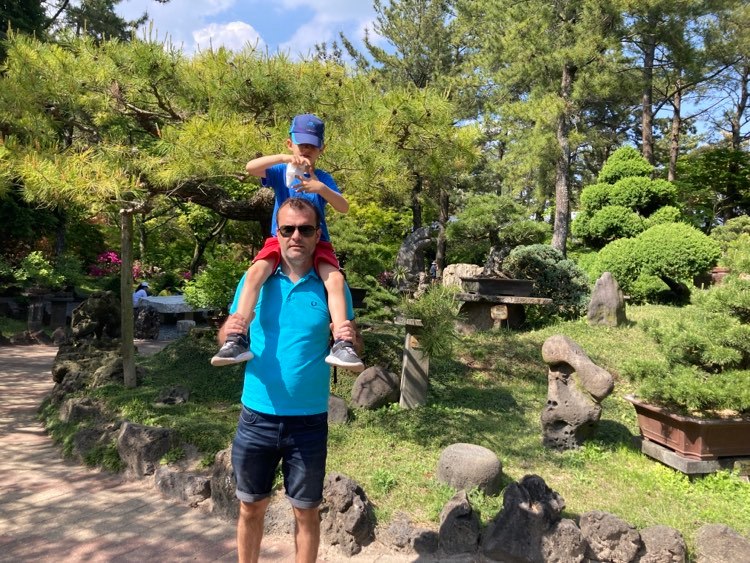
We left the park at noon and walked over to Hyopjae beach. The walk takes 5 minutes. Alternatively, you can park near the beach, but it does get crowded, especially during the afternoon and weekends. The beach is connected to the Geumneung Beach. During the afternoon, when the low tide kicks in, the turquoise shallow water dotted with porous volcanic rocks and white sand is a sight not to be missed. We spent a couple of hours here and ate at a nearby fast food. There are plenty of dining options available, depending on your taste (barbecue, sea food, fast food, etc).
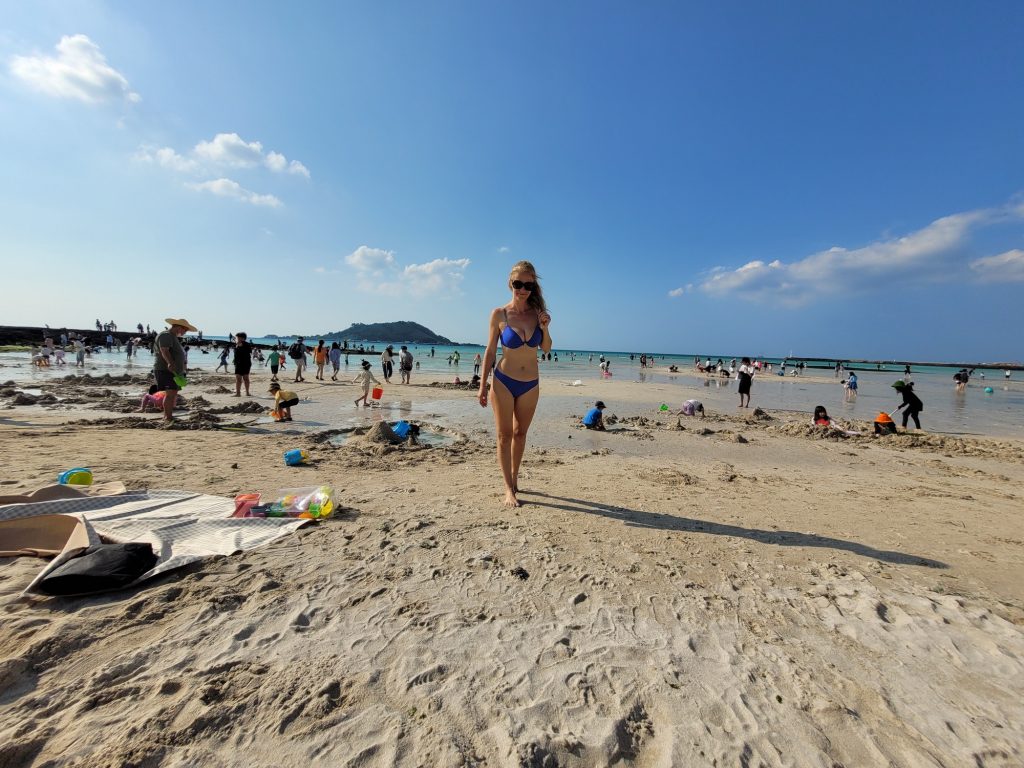
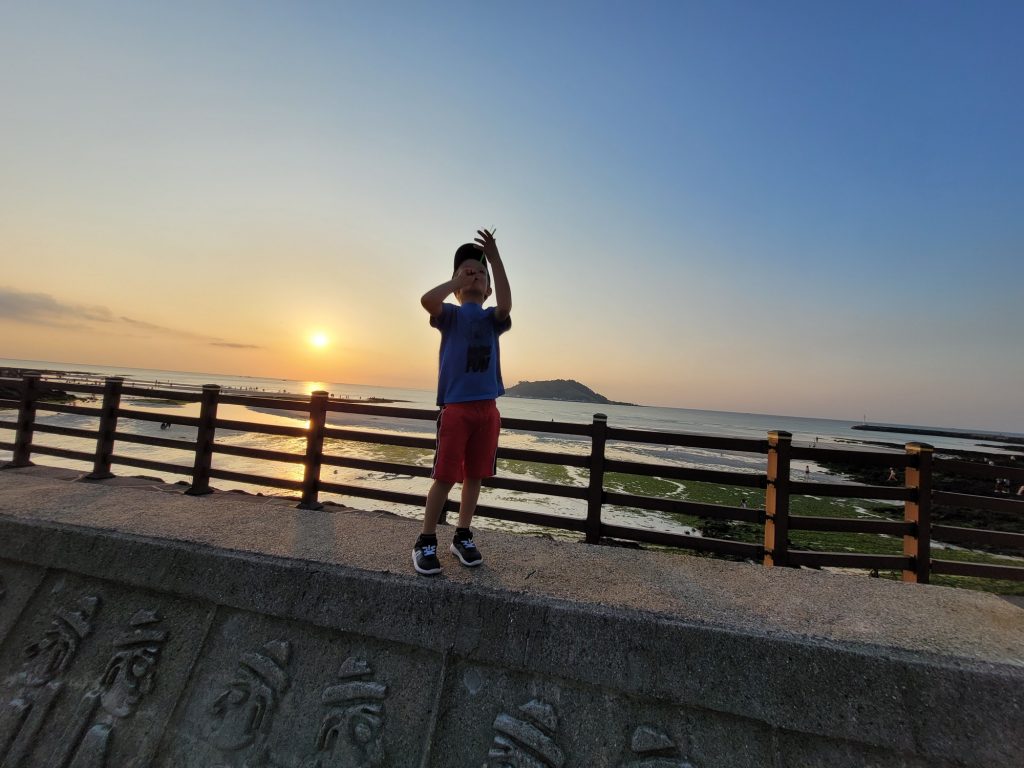
Day 4.
This was our final day in Jeju, so we chose again to do a little sightseeing and hiking during the early morning and finish the day on a new beach in the North while enjoying the sunset in a seafood restaurant. From our hotel we first headed to the Cheonjiyeon Water Falls. There is a lovely story connected to this area, which I am sure any kid will enjoy. Just follow the explanatory boards along the route and make this visit interesting for the young ones traveling with you.
There’s a large free parking lot right next to the ticket office. There are self service ticket booths that you can use quickly. The path to the waterfalls is lovely, surrounded by lush vegetation. And it is lined with small foot prints that show the direction. Eric loved this. The waterfall is indeed stunning and worth the trip.
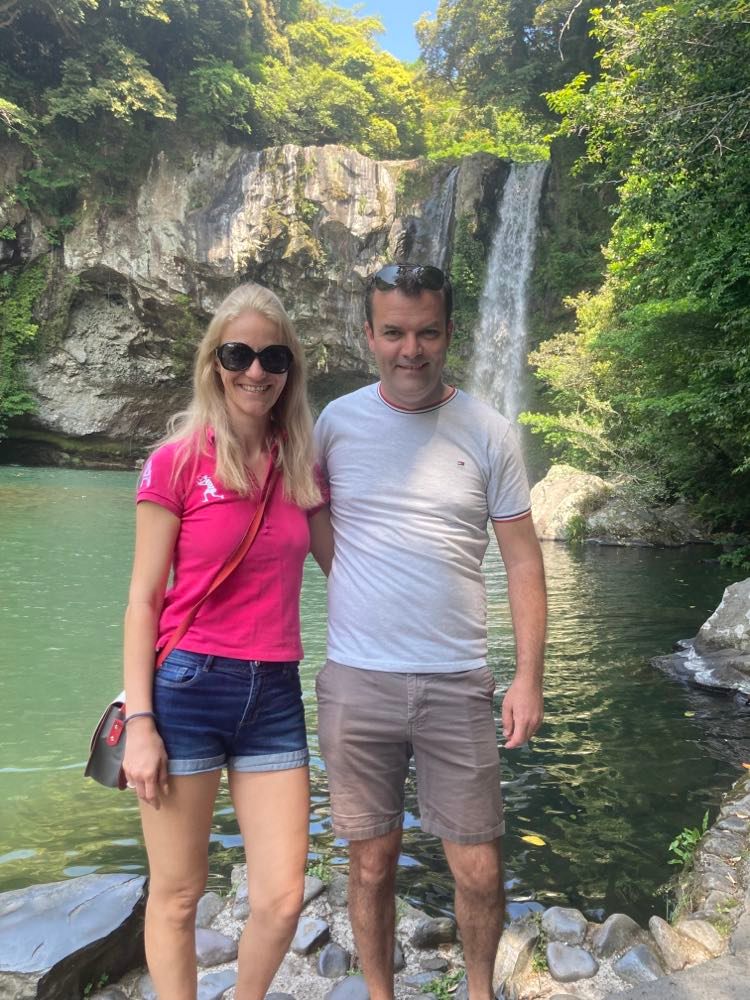
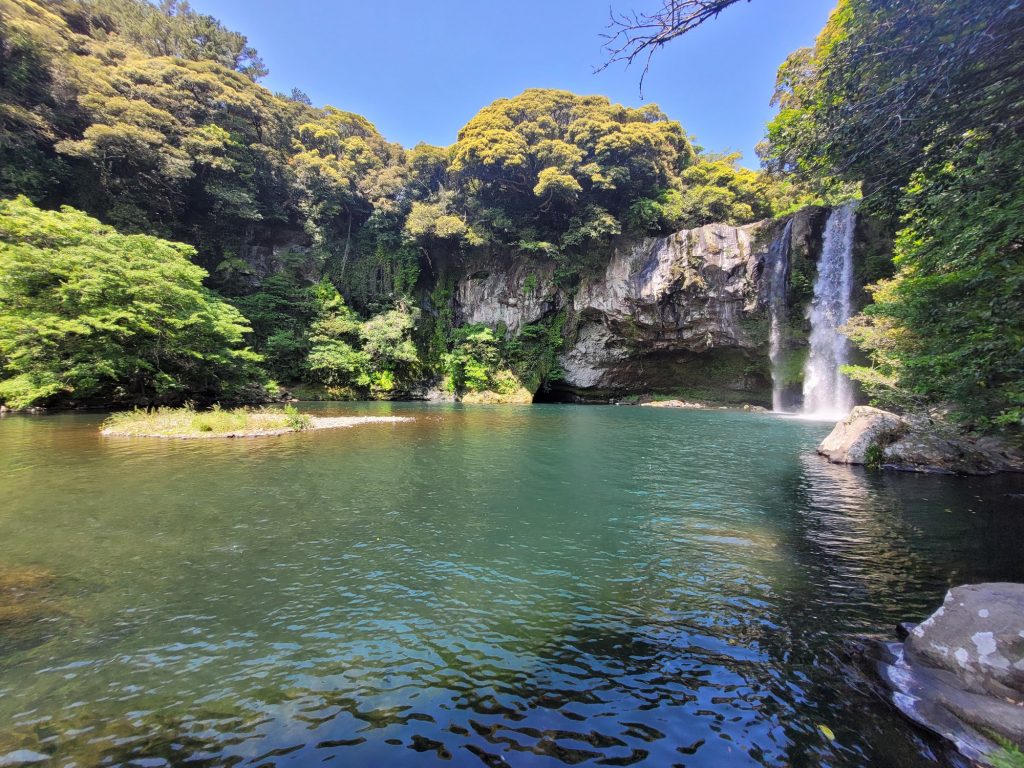
If you travel further south, to the sea, the Seogwipo submarine start its journey from here. There is a free parking lot near. From here, you can also walk along the shore to see the Seogwipo Formation, 40-m thick layers dating from the early Pleistocene. The area is good for academic purposes due to the fossil diversity (ranging from warm shallow sea fossils to those linked to cold oceans) that is used to explain the ancient marine environment of Jeju and Asia. Unfortunately, we did not stop here, but continued further to see the Seonnyeotang natural pools and the Odolgae rock, while hiking a little on the Jeju Olle Trail No. 7 (which is considered as the most scenic route). The car park is available right next to the Jeju Olle Trail. From there you descent on a dirt and rock path to reach the stairs that take you to the natural pools. The stairs are quite steep, but Eric had no problem. Swimming is permitted within clearly indicated zones. We dipped our feet in some small pools with lukewarm water. The water in the deeper pools was a little bit too cold in May and the sea was quite agitated for our taste.
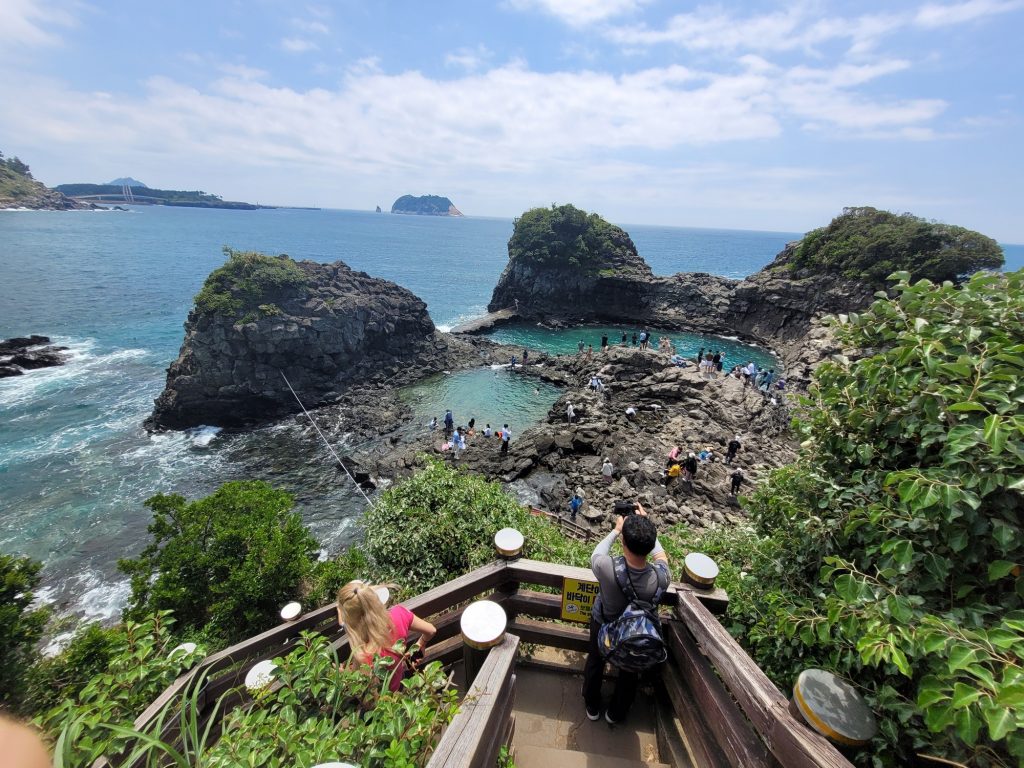
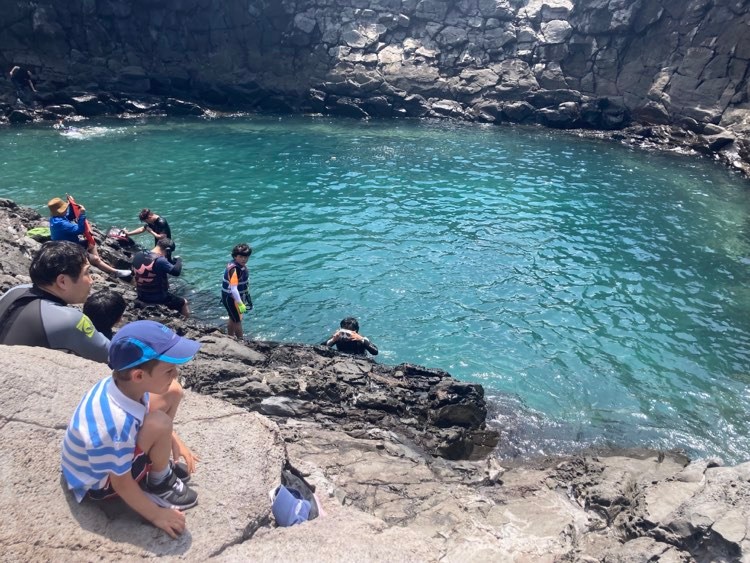
Ascend back to the wooden trail and take a right towards the Oedolgae rock (located here). The lone rock was created during volcanic eruption and it inspired many myth and stories. One of these stories tells about the Mongol invasion. Legends says that upon hearing about the Mongols sailing toward Jeju, a Korean general decided to disguise the rock to look as a giant military general. The Mongols were terrified to see the monster and feared to confront the islanders. Thus they turned their ships around and left the island. I genuinely loved these legends told on the signboards at every sight, which offered me a chance to capture Eric’s attention to talk about the island and the sights we saw. The hike from the natural pools to the Oedolgae rock is easy and short and it is extremely rewarding. We stopped a lot on our way to take in the amazing scenery with the blue waves spurring to crash on the black volcanic cliffs. It truely is a mesmerising gift of nature. From the Oedolgae rock, you can continue on the Jeju Olle Trail 7 or ascent to the parking lot. The entrance to the natural pools and the Oedolgae Rock is free. For most of the sights in Jeju a small entrance fee is however compulsory.
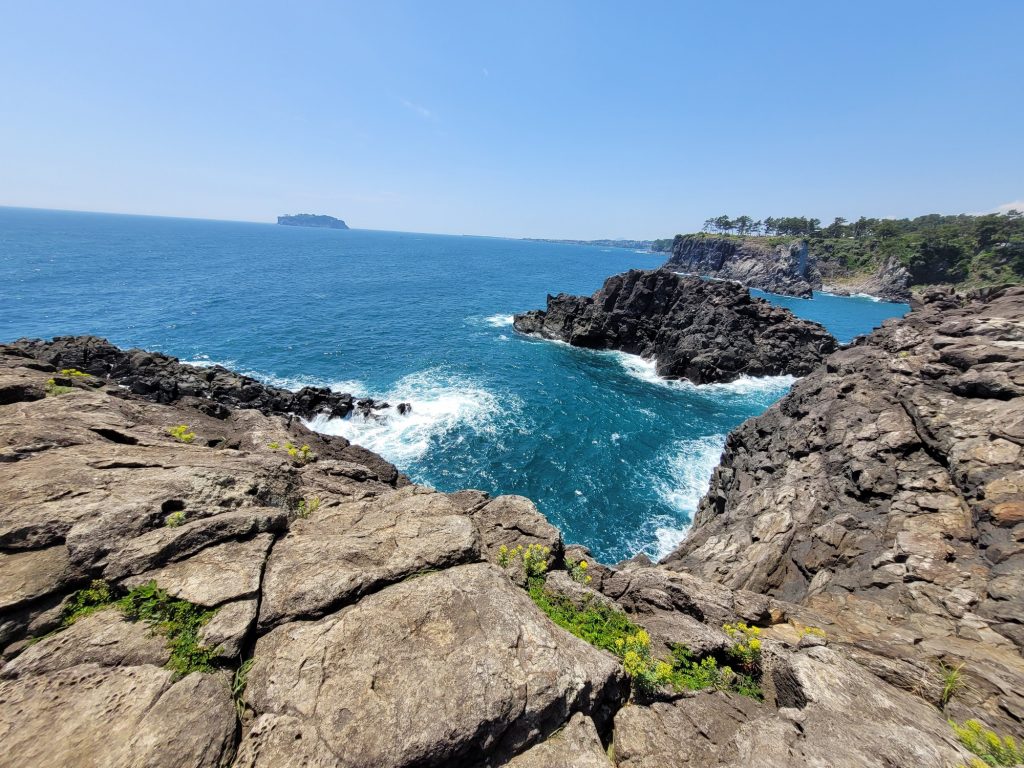
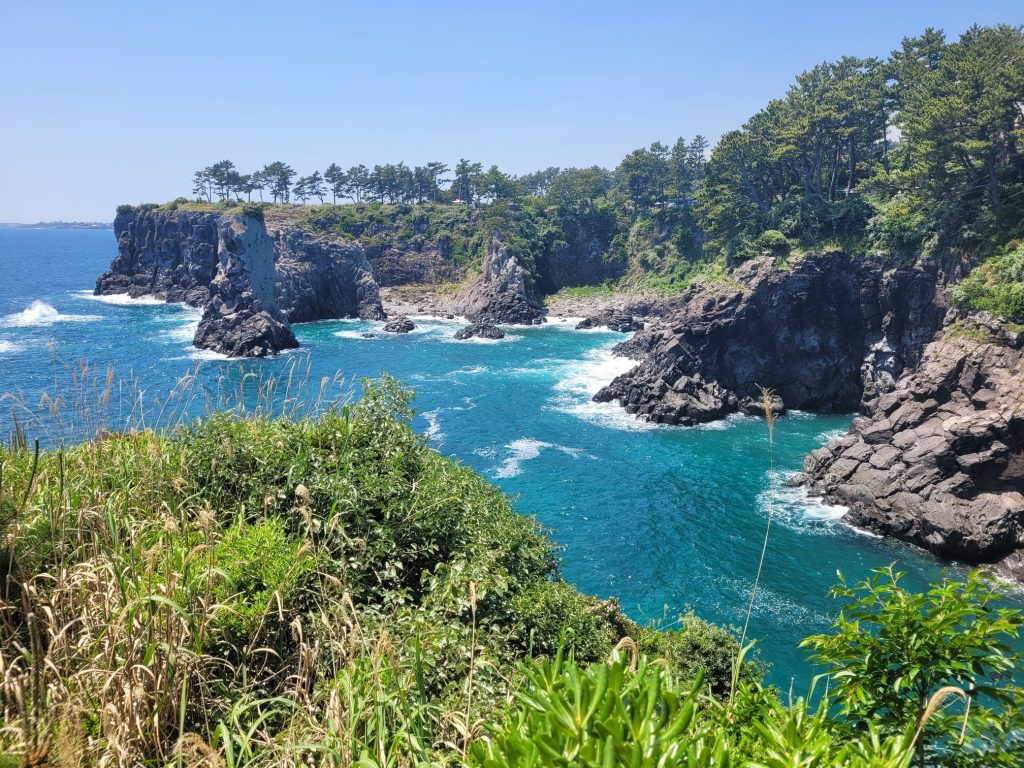
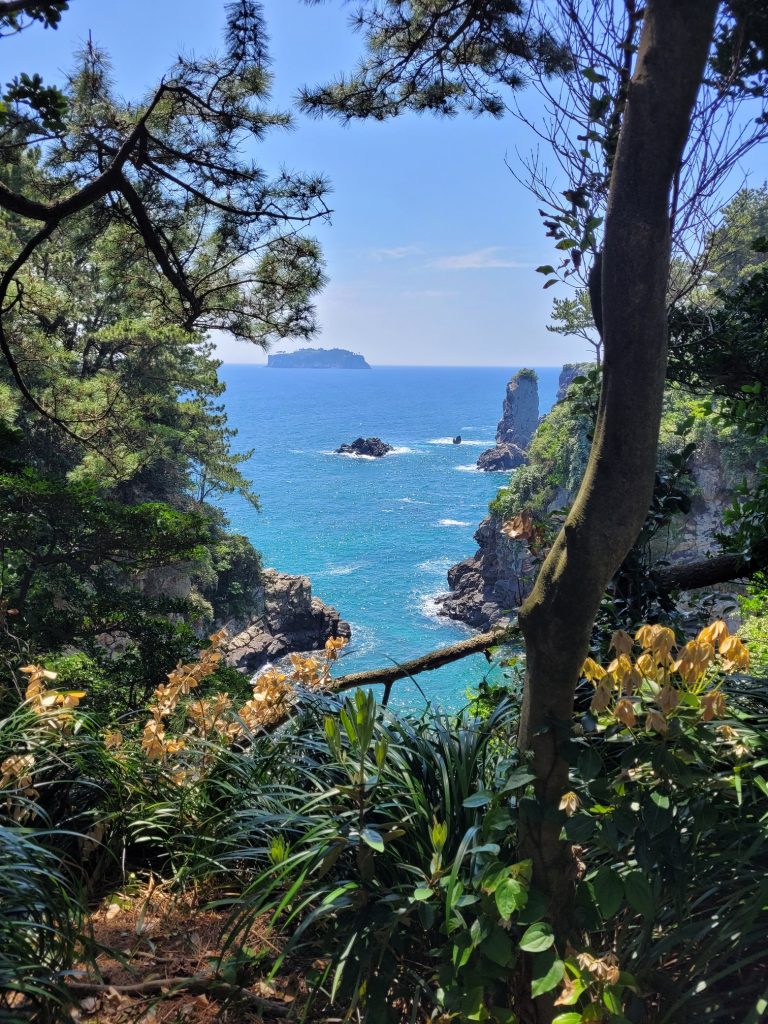
Our final destination for the day was the Gwakji beach, a lovely Northern beach with white sand and clear all-sorts-of-blue waters. Car parking that offers easy access to the beach is available here, at no charge, as all parking spots in Jeju near tourist attractions. Toilets and shower facilities are available here as well. We ended up having a sunset dinner in a seafood restaurant, right next to the beach.
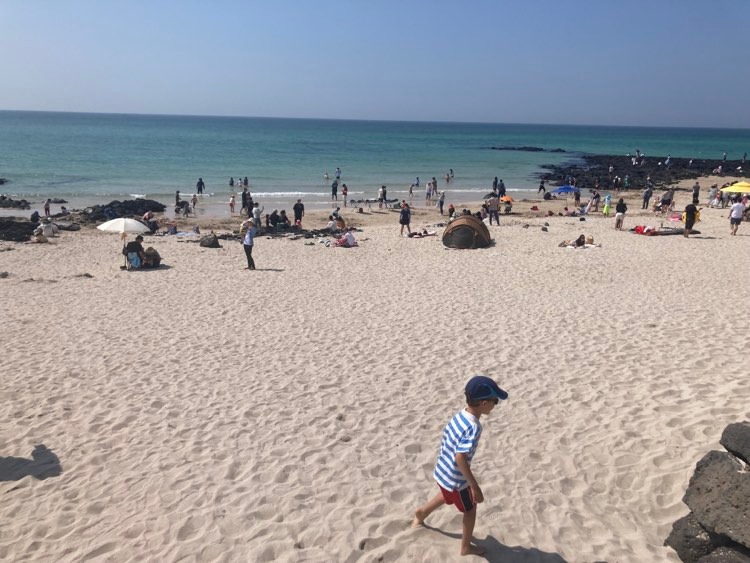
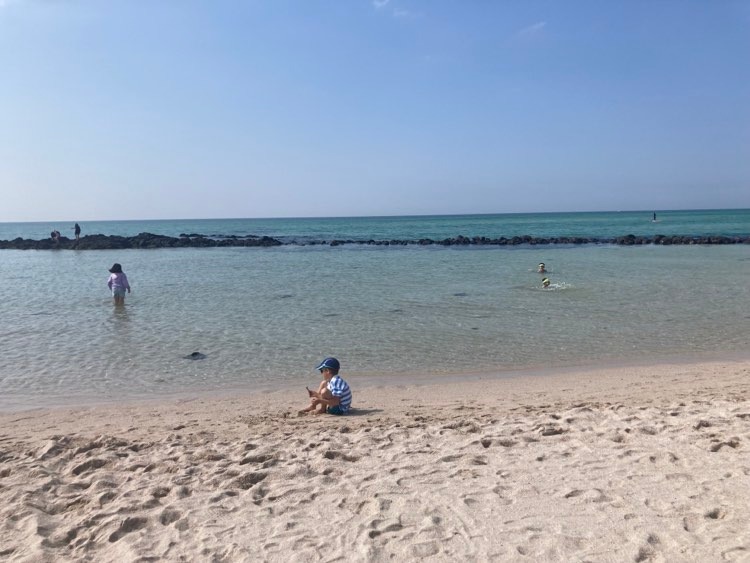
Getting to Jeju: There are a lot of airlines flying to Jeju and several flights per day operated by Busan Air, Air Asiana, Korean Air, etc. It takes about one hour from Seoul. International flights are also an option as Jeju is an international airport.
Getting around: I strongly recommend renting a car. Only possible if you have an international driving licence. Distances are short, but speed is slow. Taking public transportation will definitely limit what you see during a day. Rental cars are equipped with GPS systems, which comes in extremely handy. Kakao map is the Korean version of google maps, which works for car routes and pedestrian ones as well. A very nice, modern, 7 seater, with full insurance was about 800 euros for 5 days. You can also rent a private taxi for 8 hours to take you sightseeing. The company offering this service is called Global Taxi. Detailed info available on their website. I find this private tour as the best alternative, in case car rental is not an option.
Accommodation: Hotel Winstory – decent hotel. No cleaning though during our stay (apparently because of covid measures). We had to take out the trash in the hallway in front of our room and leave dirty towels to be exchanged. It has a washing machine, which I find very convenient when traveling with the very curious and adventurous young ones. Breakfast was very Korean, very few options, almost the same everyday. We had to cook our eggs for ourselves (apparently also because of covid measures). But, they had fresh rambutans. It was Eric’s first taste of rambutans and he ate almost all that were available every single morning (so no complaint overall… 🙂 ).
What to eat: jorim fish (boneless, so good option for kids), abalone (very common to Jeju), try the seafood hot pot (you can ask for a non spicy one), black pork barbecue. The best seafood hot pot we ate in Jeju is in Seogwipo, at a restaurant located on the first floor in the same building as Pausa Cafe, located on the 2nd floor. This is also a very nice option, both of them have a lovely view to the beach. The restaurant on the first floor is cheaper and unassuming, but the food was delicious.
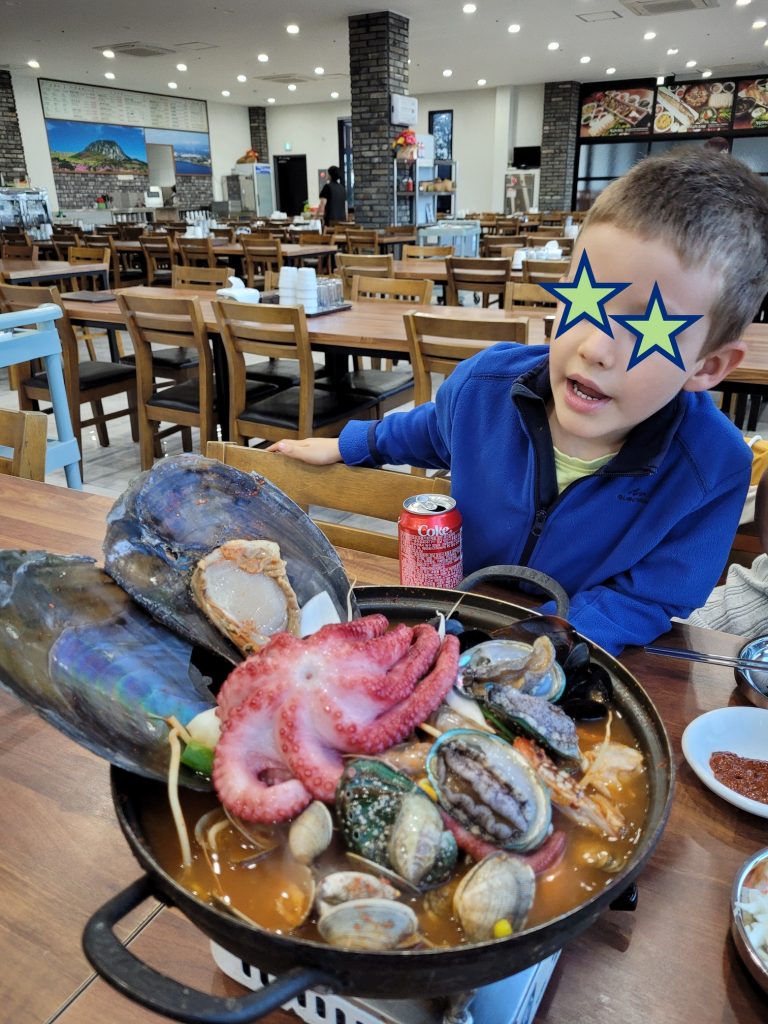
Restaurants: most restaurants close around 8pm. Very few ones have longer operating hours. Most restaurants have photos of the dishes they serve posted outside along with English description. Quite frequently, menus are in Korean only. Most people do not speak English at all, but are very friendly and willing to help out. We had no problem in ordering food.
What we did not get to see, but it was on our list: Manjanggul Cave (plan ahead and check operating hours), Jusangjeollidae Hexagonal Cliffs, Bijarim Forest (largest single species forest), Vicheollin Park or Soesokkak Estuary (for kayaking adventures) and Yongmeori Coastline (check high tide before going).
General info on sights: Most sights in Jeju have an entrance fee, but the price is decent 1-2 euros. The paths and trails are well maintained. All sights are open 9-18 hours. Entrance is prohibited after 6pm.

0 Comments